Paraphrasing: Customer Service Success’ Secret Weapon

Paraphrasing establishes trust.
Paraphrasing lowers resolution time., paraphrasing creates goodwill..
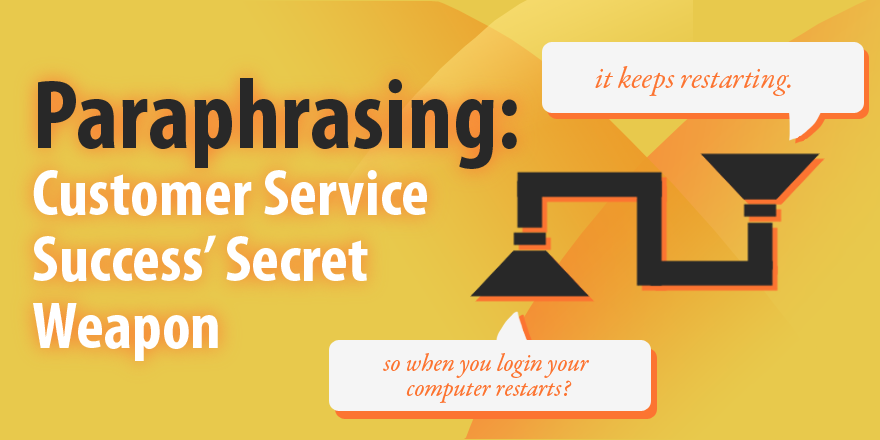
Created by Sam Garner from the Noun Project
Don’t be this guy:
Customer: Hi, I am not able to login to my machine.
Engineer: Ok! No problem, I will reset your password.
Customer: What! I know my password, I am getting an error.
Engineer: Oh I am sorry ….
What went wrong? The customer is upset and the engineer has made a lasting impression, but not a good one. It’s now going take more work on the agent’s part to get that goodwill back than if they’d made a positive impression to begin with.
Here's what should have happened.
Engineer: I’m so sorry. Would you describe to me what happens when you try?
Customer: I enter my username and password, hit enter, and then I get an error message that says “file not found.”
Engineer: So you enter your username and password, but instead of logging you in, the system gives you a “file not found” dialog box?
Active listening and paraphrasing differentiate the first and second interactions. Here’s why paraphrasing or recapping is a best practice as well as THE thumb rule of customer service.

It’s imperative for us to establish trust with a customer within the first few minutes of our support interaction. Recapping or paraphrasing helps us do that.
Always remember, every time we interact with a customer we either make a trust deposit or a trust withdrawal . When you look at the benefits of paraphrasing, it’s obvious how it helps you make trust deposits:
Ensures you have received the communication just as the customer wanted
Allows them to correct misinterpreted information
Lets the customer know you understood their problem
Determines the further course of questioning
Focuses your attention on the customer’s perspective.
Unfortunately, I am seeing too many engineers jump to connect to a customer’s machine, then find their way towards the solution. It’s an understandable instinct for an engineer. You know how computers work, people are tricky. But the machine isn’t going to decide whether to buy your product again.
And it’s not the computer that fills out a satisfaction survey. Are you getting feedback saying that the engineer did not know the product or the engineer was trying trial and error on their machine when you know your engineers know your product and computers? That’s because they’re not actively listening.

Statistically, resolution time is inversely proportional to customer satisfaction . Resolving issues quickly makes customers happy.
Paraphrasing is one of the most important steps towards a speedy resolution.
One obvious point that’s frequently forgotten in the heat of the moment is that it’s easier to find a solution when you know what the problem is. Going back to the conversation at the beginning, if the agent had logged in to change the customer’s password, it would have wasted their time and frustrated the customer. We can’t resolve issues we don’t understand. Attempting to make a customer happy when you aren’t perfectly clear on why they’re not happy right now is a waste of time for both of you.
Sure, active listening can feel like a waste of time, especially when you think you know what the problem is. But, ironically, taking the time to listen well enough to paraphrase is step-one of the kind of listening that saves you and the customer time in the end.

Paraphrasing assures customers that they are being listened to and understood. A customer that feels this way has faith in you to solve their problems. Here’s the second way paraphrasing saves time: It makes customers more cooperative. People don’t like talking when they feel like they’re being ignored or misunderstood. But you need your customers to talk to you to understand and solve their problems. And people don’t like following instructions from people they don’t trust and don’t like. Creation goodwill saves time by making customers more compliant.
While we try our hand at recapping we need to understand that the voice and tone matters a lot. We need to sound attentive and interested. Our tone sends an unspoken message, which is why we need to be very careful and positive at all times. While we paraphrase we should send a signal that we are hearing everything the customer says and trying to understand. We need to be open to correction. This give a very good picture of you in customer’s mind enabling him to correct you without the fear of being judged or going unheard.
Active listening and paraphrasing take your customer service from ordinary to extraordinary. Paraphrasing establishes trust, lowers resolution time, and creates goodwill.
Do you include paraphrasing as a matter of course in your customer service interactions? Is it part of your agent training? Why or why not? Let us know in the comments!
Images by Abby Kahler
Was this article helpful?
About the author.
Ravi Verma is an experienced support delivery manager with more than 10 years of experience providing thorough and skillful consumer support to enterprise-level internal and external users.
Related Reading
Is it time to outsource appointment setting services, inbound vs. outbound call centers: choose the right strategy, customer service vs. customer support, 6 top-rated ai-enabled tools for customer service, retail strategist reveals how technology can deliver personalized and frictionless experiences, capterra value report: a price comparison guide for call center software, 6 top-rated free survey tools, global thought leader on customer loyalty explores the ‘science of effort’ in ex and cx, sales researcher says ai-enabled tech is the key to uncovering b2b sales insights.
Cookie Preference Centre

Your Privacy
When you visit any web site, it may store or retrieve information on your browser, mostly in the form of cookies. This information might be about you, your preferences, your device or used to make the site work as you expect it to. The information does not usually identify you directly, but it can give you a more personalized web experience. You can choose not to allow some types of cookies. Click on the different category headings to find out more and change our default settings. However, you should know that blocking some types of cookies may impact your experience on the site and the services we are able to offer.
Strictly Necessary Cookies Always Active
These cookies are necessary for the website to function and cannot be switched off in our systems. They are usually only set in response to actions made by you which amount to a request for services, such as setting your privacy preferences, logging in or filling in forms. You can set your browser to block or alert you about these cookies, but some parts of the site may not work then.
Cookies used
ContactCenterWorld.com
Performance Cookies Active
These cookies allow us to count visits and traffic sources, so we can measure and improve the performance of our site. They help us know which pages are the most and least popular and see how visitors move around the site. All information these cookies collect is aggregated and therefore anonymous. If you do not allow these cookies, we will not know when you have visited our site.
Google Analytics
Functional Cookies Active
These cookies allow the provision of enhance functionality and personalization, such as videos and live chats. They may be set by us or by third party providers whose services we have added to our pages. If you do not allow these cookies, then some or all of these functionalities may not function properly.
Targeting Cookies Active
These cookies are set through our site by our advertising partners. They may be used by those companies to build a profile of your interests and show you relevant ads on other sites. They work by uniquely identifying your browser and device. If you do not allow these cookies, you will not experience our targeted advertising across different websites.
This site uses cookies and other tracking technologies to assist with navigation and your ability to provide feedback, analyse your use of our products and services, assist with our promotional and marketing efforts, and provide content from third parties
Tell a Friend!
Share this page with your contacts and let them know you visit ContactCenterWorld.com
I am checking out all the amazing and daily updated content on ContactCenterWorld.com and networking with professionals worldwide
Here are some suggested Connections for you! - Log in to start networking.
Verbatim or paraphrasing: which call center script is best for you - the connection - contactcenterworld.com blog, verbatim or paraphrasing: which call center script is best for you.
Call centers use scripts for several reasons. Scripting allows you to control messaging and ensure agents are providing a consistent service experience to every customer. Scripts help move calls along efficiently. And they can reinforce your brand as a helpful listener. But different styles of scripts work best in different situations.
Here is a comparison of two common styles of scripts and why they may or may not be best for your purpose.
Types of Call Center Scripts
There are two types of call center scripts commonly used — verbatim and call flow or paraphrasing. Each type has its place in the customer service industry, so it is up to you to decide which style works best for your brand.
Sometimes you want a call center script that agents can read verbatim. This works well when calls are generally short and transaction-based, or, for example, when a disclaimer needs to be read.
Advantages of a verbatim script:
- No need for agents to deviate from the script.
- The call center can control messaging and branding.
- It is easy to direct callers through a call flow.
- Mitigates agent errors
- Easier to check for quality assurance
- You receive expected outcomes.
- It is easier to coach agents to be exact.
Disadvantages of a verbatim script:
- Messaging can sound robotic and disingenuine.
- Agents can become flustered when a call does not go as expected.
- Agents can become bored and unchallenged.
- Agents may become angry when coached repeatedly if one or two words are off script.
Call Flow or Paraphrasing
Call flow, or paraphrasing, scripts act more as a guide to an agent's call. They can also be referred to as Freeform scripts. This type of script provides key phrases and expressions, and an outline of what typically happens on a call. They are often longer, more complex, and require the agent to use institutional knowledge. Paraphrasing scripts are commonly used when it is uncertain what the caller may need during the transaction.
Advantages of a paraphrasing script:
- Agents have the freedom to make logical decisions around a guide they must follow on a call.
- Callers typically remember the conversation because it is longer and about the agent and caller, not a step-by-step transactional call.
- Agents can feel challenged and appreciated for their knowledge.
- It is more engaging and genuine.
Disadvantages of a paraphrasing script:
- More difficult to train agents
- Training typically lasts longers.
- More challenging to grade for quality assurance
As you can see, verbatim and paraphrasing scripts are beneficial for different reasons. The type of script you use for your company depends on the scope and purpose of your call center. No matter what script you choose, your customers should feel well taken care of by your agents.
Source: https://blog.theconnectioncc.com/verbatim-or-paraphrasing-which-call-center-script-is-best-for-you
2024 Buyers Guide Get Listed Payment Services

NEXTGEN-TV PROGRAMMING
NOW PLAYING Starting on the hour every hour today
Coming up this Week
Upcoming Events
LOGIN WITH YOUR CONTACTCENTERWORLD.COM ACCOUNT
You need to complete your Member Profile to access this content!
All members are required to complete their Individual Membership Profile to access all the exclusive member-only content.
You need to upload a photo before you can access this page!
To complete your Member Profile and unlock all your member benefits you need to upload a photo to your profile. Yes, we know it sucks but it's a requirement for all members as it helps build a stronger community for us all - it only takes a minute!
About ACXPA
- National Advisory Board
- ACXPA Victoria
- ACXPA South Australia
- ACXPA Queensland
- ACXPA Tasmania
- ACXPA Western Australia
- Practitioner Advisory Boards
- Excellence Awards
- Rewards Program
- Speaker Opportunities
- Our Sponsors
- Sponsorship Packages
- Accredited Training Providers
- Privacy Policy
- Privacy Collection Notice
- Events Terms & Conditions
- Website Terms of Use
- Individual Membership
- Business Membership
- Vendor Membership
- Compare Memberships
- Learn more about ACXPA
- Training Courses
- CX Community Roundtables
- Contact Centre Manager Roundtables
- Member Symposiums
- All upcoming events
- Team Leaders
Customer Experience (CX)
- Customer Service
- Digital CX & Technology
- Employee Experience
- Curated Industry News
- View Guest Authors
- View All Articles
- Individual Members
- Business Members
- Industry Suppliers
- Call Centre Rankings Reports
- Customer Experience
- Contact Centre Management
- General Knowledge Trivia
- General Management
- Job Descriptions
- Phonetic Alphabet
- Erlang Calculator
- View all downloads
- Call Centre Rankings
- 2023 Best Practice Report
- Customer Experience (CX) Stats
- Industry Information
- Industry Knowledge
- General Trivia
- Contact Centre Quality Standards
- Exclusive Content
- Industry Glossary
- Featured Members
- CX Matters Podcast
- Shop/Marketplace
- Latest National Results
- Car Insurance
- Energy Retailers
- Internet Retailers
- How to add your sector >
- Contact Centre CX Benchmarking
- Customer Service Benchmarking
- Australian Quality Standards
- More Industry insights & Data >
- Outages/Change Log
- Private Groups
- Support Forums
- Submit Guest Post
1800 022 972 [email protected]
As well as the great article below, ACXPA Members also have access to a range of additional resources, including our monthly Member Symposiums & Video Library, exclusive industry insights, premium resources to download , discounted training courses , expert articles , and lots more!
Learn more about our Individual Memberships >
Paraphrasing
Paraphrasing in a call centre or customer service setting is restating a customer’s issue or question with new words or phrases while keeping the same meaning to demonstrate you understand what they are telling or asking you.
It is often used to demonstrate active listening skills , one of the most important tools in customer service.
Why paraphrase on the phone?
Phone conversations can be difficult, especially when addressing complex, sensitive, or emotional topics with customers.
As the conversations are being held over the phone, visual cues such as facial expressions, gestures, and eye contact are missing and research shows that approximately 60% of human communication is typically visual.
Add to this the background noises and distractions often encountered over the phone and it can also interfere with concentration and comprehension.
So when we lose 60% of our communication powers, we need to make sure the other 40% is on-point which is typically made up of tone and the words we use.
Paraphrasing is a useful tool to help overcome these issues and enhance your communication skills.
Paraphrasing allows you to confirm your understanding of the speaker’s message and feelings, demonstrating that you are listening attentively and respectfully as well as aiding in building rapport and trust with the speaker by acknowledging their feelings and expressing empathy.
An example of how to paraphrase on the phone
When paraphrasing on the phone, it is important to not simply repeat what the speaker said word for word.
Instead, use your own words to summarise, restate, or reflect on what the customer has said, while keeping the same meaning and tone.
An example of this could be, “OK <insert name>, my understanding is that <we need to/you’re trying> to<information>, is that correct?”
Search more Glossary Terms >
CX Roundtables - Upcoming Guest
Live and interactive sessions for customer experience p rofessionals in Australia.
Contact Centre Manager Roundtables - Upcoming Guest
Live and interactive sessions for contact centre professionals in Australia.
Next Members Symposium Livestream: Tuesday, 21st May, 2024, 13:30 AEST
The Members Symposium sessions are only available to ACXPA Members!
ACXPA Members can watch the symposium live, and, can watch any of the sessions at any time in their Video Library.
Discover which membership is right for you >
Preview of upcoming Symposium Sessions:
IVR Best Practice
Over 90% of contact centres are using an IVR (Press 1 for this, press 2 for that), and we've encountered many contact centres with over four layers of options for customers to select from. In this session, Nadine will be sharing some best practice tips on IVR design for 2024.
Presented by Nadine Power , Chief Product Officer, Datagamz (and ACXPA National Advisory Board Member)
Tips to Boost Engagement on Calls
Of the five quality competencies we assess as part of the Australian Call Centre Rankings , the 'ENGAGE' competency from the Australian Contact Centre Quality Standards has consistently been at the bottom of the rankings throughout 2023 and into 2024.
In this session, Simon will provide some tips that can be shared with agents on how to increase engagement with customers at the start of calls.
Presented by Simon Blair , General Manager Quality Insights, ACXPA
More sessions announced soon!
(If you're interested in speaking at one of our events, click here to learn more > )
View the latest results >
Subscribe to ACXPA >
Latest Articles
Contact centres and digital platforms: a symbiotic bond, expert tips on how to handle overflow calls in the call centre, latest podcast, from the kitchen to the contact centre, latest glossary terms, csat (customer satisfaction), upcoming courses & events, may 2024 customer service phone professionals, may 2024 how to assess and coach contact centre agent performance, may 2024 tech support customer service essentials, may 2024 customer service reception essentials, may 2024 real-time wfm for contact centre analysts, acxpa platinum sponsors, acxpa gold sponsors, acxpa silver sponsors, acxpa bronze sponsors.
The Australian Customer Experience Professionals Association (ACXPA) is the leading industry association in Australia for the contact centre, customer experience, customer service and digital service professions in Australia.
We provide global best practices, industry insights, world-class training and an unrivalled community of industry professionals that help Australian businesses deliver efficient and effective customer experiences via voice, digital and in-person channels.
Learn more about ACXPA >
Find Industry Suppliers
Search the ACXPA Supplier Directory to find Outsourcers/BPOs, Contact Centre Technology, Training Companies, AI & Automation, Consultants, Telemarking Lists and lots more.
Search the Supplier Directory >
Use our free service to connect to Contact Centre Outsourcing/BPOs or Contact Centre Technology suppliers that can meet your specific requirements.
Find the perfect supplier >
Australian Call Centre Rankings Q4 2023
Popular links.
Call Centre Rankings >
Contact Centre Articles >
Customer Experience Articles >
Customer Service Articles >
Industry Insights & Data
Upcoming Events
Members Symposiums >
Downloads >
Industry Quizzes >
CX Matters Podcast >
Are you sure you want to delete post?
This post cannot be restored anymore.
Log in with your email address
or Become an ACXPA Member
Forgot your details?
Create account.

3 Benefits of Paraphrasing: The Skill for Learning, Writing and Communicating
Paraphrasing is the underrated skill of reinstating, clarifying or condensing the ideas of another in your own words. By paraphrasing, you can curate credible and well-developed documents, and arguments. But there’s more to paraphrasing than the final result, the process of paraphrasing engages your ability to learn actively, write well, and communicate creatively.

Paraphrasing allows you to share another’s ideas in your own words. This powerful technique is useful in both written and verbal communication, and acts as a tool for conveying information effectively. Paraphrasing is an underrated skill that is beneficial to a variety of individuals from students and writers to employees and business owners. In any setting, sharing information well is the key to good quality work and results. The process of paraphrasing itself also has a number of benefits, making you a better learner, writer and communicator.
Paraphrasing: The Active Learning Strategy
Paraphrasing requires you to think about the information you want to convey. You need to understand the meaning in order to reword and restructure the idea, and share it effectively. The process of paraphrasing encourages you to get to the core message, and improves your understanding of the material. In this way, you are actively engaging with the material . Instead of passively reading, you are breaking down the ideas and concepts. Rather than slotting information into your writing, you’re reworking and tailoring it to your needs and your audience.
Paraphrasing can improve your memory by encouraging you to engage with the information. The 5-step approach to paraphrasing suggests writing your first paraphrase without looking at the original material. This engages your ability to actively recall information from memory, and think of new ways to write it out, rather than simply trying to memorise what you read word for word. After your first draft, you’ll revisit the original material to check if your work conveys the same meaning, this part of the process can further strengthen memory. You’re again revisiting the material in a way that is active and assessing your understanding. Likewise, the practice of paraphrasing improves your ability to convey information, ensuring that it is well-written and tailored to your audience.
This learning method is particularly useful for exams. You’ll learn the material well, developing a deep understanding and continue to refine this as you paraphrase the information. You’ll also be practising your ability to share this information in a way that is well-written, avoids plagiarism and engages your audience. This means, you’ll be able to easily add these ideas into your assignments or exams, having already taken the time to understand the ideas deeply and even practised sharing this information. You’ll be able to show the depth of your learning through paraphrasing, proving you understand the bigger picture and the finer details.
Paraphrasing: The Technique for Improving Writing Ability
Once you’ve understood the concept well, the process of paraphrasing can improve your writing ability in a variety of ways. You’ll improve your vocabulary by making use of synonyms and identifying key words. You might also switch between word categories, using a noun instead of a verb or changing adjectives into adverbs. Overtime, this will make you a better writer. Paraphrasing is more than changing a few words and can involve switching between the active or passive voice, this can improve your ability to distinguish between the two. Effective paraphrasing also involves playing around with sentence structure, you might utilise shorter or longer sentences to convey the idea at hand.
These benefits can still be found even when using paraphrasing tools . You’ll still have to test your understanding by assessing the paraphrase the tool produced. Likewise, you’ll be exposed to new ways of writing things, new words, sentence structures, and organisation. You’ll learn how to pick out the paraphrasing styles that do or don’t work for your writing. Beyond the more technical aspects of writing, paraphrasing can also teach you how to communicate more clearly. You might rearrange the information to emphasise a particular point, or simplify the language to make it accessible to your audience. This improves your ability to clarify the ideas of the original material, and make ideas that might be overly complex, easier to digest.
Paraphrasing: The Skill for Better Communication
Finally, paraphrasing can make you a better and more creative communicator. By engaging in the process of paraphrasing, you’re developing your ability to share one idea in a variety of ways. For this to be engaging, you have to get creative. You might play around with the tone, switching between formal, informal, casual, or persuasive. Imagine a business launching a new product, communicating the idea to various internal teams, and customers, each would require a different approach and yet the meaning behind the information would remain the same.
You might ask questions such as, how can I tailor this information to my audience? How can I bring this aspect of the idea to life? This highlights how paraphrasing can really exercise your ability to communicate creatively. Similarly, paraphrasing can teach you how to share ideas in your own personal way. Whether you’re sharing an idea with a friend, or on social media, you’ll find you can share information in your own personal style while still retaining the original meaning. This can make ideas more accessible and relatable to those in your circle. Additionally, this can prove to be a useful skill in your career, studies or creative endeavours.

Do you want to achieve more with your time?
98% of users say genei saves them time and helps them work more productively. Why don’t you join them?
About genei
genei is an AI-powered research tool built to help make the work and research process more efficient. Our studies show genei can help improve reading speeds by up to 70%! Revolutionise your research process.
Articles you may like:

Find out how genei can benefit you

- Brand Representation
- Call Center Training
- Customer Experience
- KPI Management
- Omni-Channel Contact Center
- Quality Assurance
- Scalability
- Technology & Updates
- Workforce Management
- Contact Tracers
- Call Types Handled
- Interactive Voice Response IVR Systems
- Live Agent Outsourcing
- Email Response Outsourcing
- Live Chat Outsourcing
- Consulting Services
- Curriculum Development
- Learning Management System (LMS)
- Media Communications
- Consumer Services & Retail
- Data Breaches, Recalls & Adverse Events
- Direct Sales & Social Commerce
- Financial Services
- Workforce Calculator
- Talent Blog
- Request A Quote
Tips from the Pros

Verbatim or Paraphrasing: Which Call Center Script is Best for You?
Call centers use scripts for several reasons. Scripting allows you to control messaging and ensure agents are providing a consistent service experience to every customer. Scripts help move calls along efficiently. And they can reinforce your brand as a helpful listener. But different styles of scripts work best in different situations.
Here is a comparison of two common styles of scripts and why they may or may not be best for your purpose.
Types of Call Center Scripts
There are two types of call center scripts commonly used — verbatim and call flow or paraphrasing. Each type has its place in the customer service industry, so it is up to you to decide which style works best for your brand.
Sometimes you want a call center script that agents can read verbatim. This works well when calls are generally short and transaction-based, or, for example, when a disclaimer needs to be read.
Advantages of a verbatim script:
- No need for agents to deviate from the script.
- The call center can control messaging and branding.
- It is easy to direct callers through a call flow.
- Mitigates agent errors
- Easier to check for quality assurance
- You receive expected outcomes.
- It is easier to coach agents to be exact.
Disadvantages of a verbatim script:
- Messaging can sound robotic and disingenuine.
- Agents can become flustered when a call does not go as expected.
- Agents can become bored and unchallenged.
- Agents may become angry when coached repeatedly if one or two words are off script.
Call Flow or Paraphrasing
Call flow, or paraphrasing, scripts act more as a guide to an agent's call. They can also be referred to as Freeform scripts. This type of script provides key phrases and expressions, and an outline of what typically happens on a call. They are often longer, more complex, and require the agent to use institutional knowledge. Paraphrasing scripts are commonly used when it is uncertain what the caller may need during the transaction.
Advantages of a paraphrasing script:
- Agents have the freedom to make logical decisions around a guide they must follow on a call.
- Callers typically remember the conversation because it is longer and about the agent and caller, not a step-by-step transactional call.
- Agents can feel challenged and appreciated for their knowledge.
- It is more engaging and genuine.
Disadvantages of a paraphrasing script:
- More difficult to train agents
- Training typically lasts longers.
- More challenging to grade for quality assurance
As you can see, verbatim and paraphrasing scripts are beneficial for different reasons. The type of script you use for your company depends on the scope and purpose of your call center. No matter what script you choose, your customers should feel well taken care of by your agents.
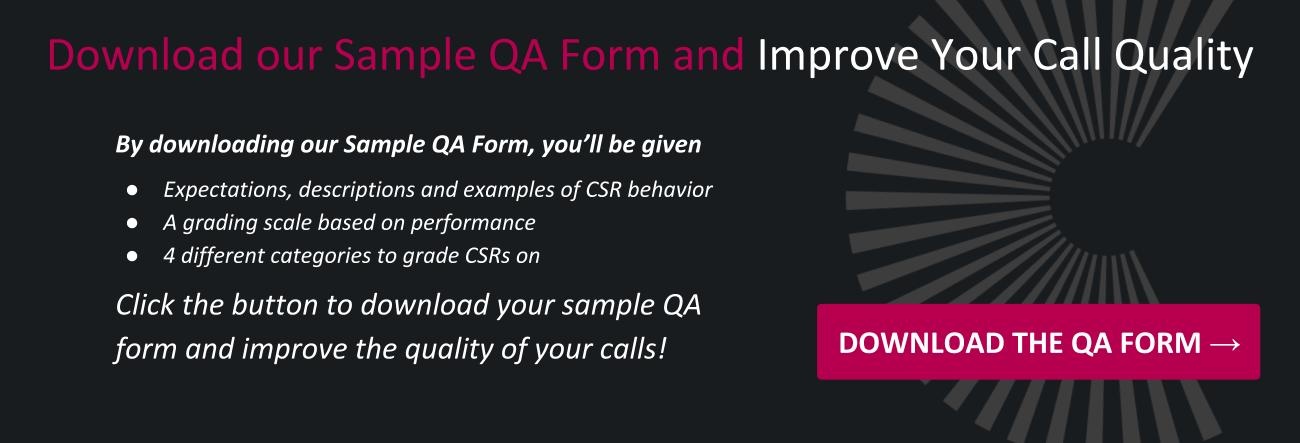
Share this post
Subscribe to talent blog notifications.
- Call Center Management (30)
Get in Touch

The Connection® is a business process outsourcer (BPO), offering a multitude of operational and consulting services for contact center services.
Address: Bloomington, MN 55437
Phone: +1 (952) 948-5488
Fax: +1 (952) 948-5498
Blog Signup
© Copyright 2024 The Connection®. All Rights Reserved.
- Português (Brasil)
Contact Center Trends
14 tips for amazing call center customer service

By Celia Cerdeira

Customer service expectations have risen significantly over the last few years. According to a recent study from Salesforce , 88% of customers surveyed say that the customer service experience is just as important as products or services when making a buying decision—up from 80% in 2020. And almost everyone surveyed (94%) stated that a positive customer service experience makes them more likely to purchase a product again.
Providing an exceptional customer experience is no longer optional in today’s world, it’s a necessity.
To enhance your contact center’s performance , it is essential to train and develop knowledgeable, empathetic, and efficient customer service agents. The following customer service tips for call centers can help reinforce existing training or serve as a foundation for a strong enablement program that helps your agents confidently address customer concerns, provide accurate information, and deliver a personalized customer experience.
14 customer service tips for contact centers.
The following customer service tips are deeply rooted in the principles of effective communication, empathy, and problem-solving and can dramatically improve your customer interactions.
1. Engage in active listening.
Active listening allows for a better understanding of the customer’s needs and shows the agent’s willingness to help. To listen actively, allow the customer to talk without interruption, reflect their main question or concern back to them, and ask clarifying questions as necessary.
2. Highlight understanding.
Ensure that each customer is aware that you understand their needs. By repeating each customer’s concerns back to them and asking relevant questions, customer service agents can communicate that they understand the customers and are making an effort to help solve their problems.
3. Be courteous.
Be polite and have respect for your customers. Always use “please” and “thank you” to create an inviting contact center environment and build positive customer relationships. Let your customer finish speaking before you begin speaking, and always maintain a professional and calm tone of voice.
4. Call the customer by their name.
Ask the customer their name and pronounce it correctly. This communicates respect for the customer and lets them know that they are important.
5. Go the extra mile.
Demonstrate through actions that the customer is important by giving more than the minimum effort required. This could be something as simple as reviewing their previous call notes so you can speak with authority on their inquiry.
If you have access to all of their products and services, conduct a quick review to ensure your customer has everything they need in addition to a resolution to their inquiry. Is there a way you can save them money by bundling their services? Take the initiative to provide better service or give the customer something extra to make them feel valued and appreciated.
6. Ask open questions.
Rather than simply repeating your customer’s statements, ask questions that encourage the customer to give more information in their own words. For example, if the customer mentions a fee, don’t just repeat what they say “So you’re calling about a fee.” Instead, ask an open-ended question: “I see you are calling about a fee on your account. Would you mind telling me a little bit more so I can help you?” Asking appropriate questions makes the conversation more collaborative and gets to the root cause of the issue.
7. Empower customers with the right information.
Giving customers all the information they need empowers them to make informed decisions. When there are options, thoroughly describe each available alternative. This will help them be more involved in solving their problems and result in higher customer satisfaction.
You’ll also want to ensure that you’re providing accurate responses to customer inquiries, so you can resolve their queries faster. By using an AI-powered knowledge management tool, agents can get complete answers to customer queries with just a quick search.
Interested in learning more?
Connect with our team to see how Talkdesk can level-up your Call Center Software Solutions.
8. Explain your processes.
Customers are not always familiar with your company’s policies or procedures. Thoroughly explain to customers what you’re doing and why you’re doing it. Clear understanding tends to decrease customer frustration.
9. Use simple language.
Avoid technical terms, jargon, and acronyms . Be professional, concise, and clear.
10. Elevate to a supervisor when necessary.
When the customer’s needs are beyond your expertise or level of competency, refer them to a colleague, a supervisor, or a manager. Always explain to the customer that they will be transferred to someone who can effectively address their problem.
11. Be empathetic but keep it professional.
Be aware of the way your customer is speaking. While it can be hard to listen to an upset or angry customer , it is important to remain professional. Approach the conversation from a place of empathy without over-promising. Make your customer feel heard, and keep focused on the solutions rather than the problem. This way your customer feels understood, and knows you are working to find a resolution that will benefit you both.
12. Be proactive.
Your primary goal is to resolve their immediate issue, but don’t stop there! Find ways to proactively improve all aspects of your customer’s experience while you have them in front of you.
One great way to do this is to make sure your customer’s personal details are up to date. Confirm that you still have their correct phone number, address, and email. Also, if it has been some time since your customer’s last interaction, why not see if their services and products are still the best fit for their current situation? A proactive check-in with your customer could be the difference between a neutral NPS score and a 9 or a 10.
13. Personalize your recommendations.
Providing personalized recommendations can help a customer resolve their query faster and increase customer satisfaction. Explain why you are making the suggestion based on what you have discovered in your conversation, and from a scan of your customer’s contact record. Artificial intelligence (AI) tools like virtual agents and knowledge bases can also help you to be proactive and efficient by prompting automated suggestions on query solutions.
14. Take detailed call notes and create an after-call summary.
Taking detailed call notes and providing an after-call summary is essential for excellent call center customer service. It can be difficult since agents typically need to quickly move on to their next call and increase their speed-of-answer rate. But, it’s important to take the extra step to accurately summarize the interaction in the customer’s call notes so that agents can save the customer from any frustration if they call again about the same issue.
You don’t need to do this process manually anymore. AI-powered tools, such as automatic summary from Talkdesk, use the same LLM powering ChatGPT to create after-call summaries instantly, reducing the amount of after-call work for agents.
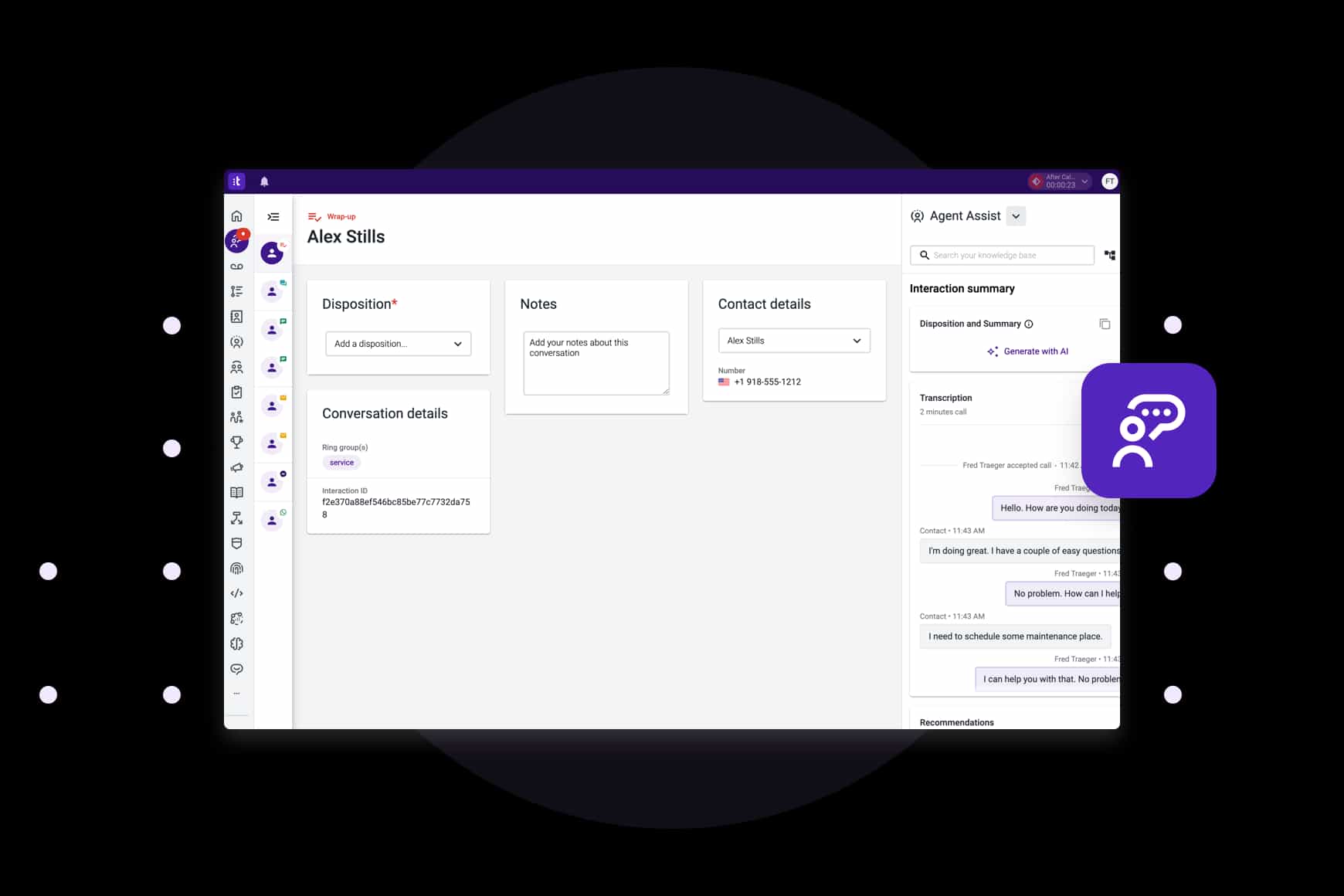
Interactive demo
See Talkdesk Agent Assist GPT-powered automatic summary in action.
This self-guided demo will allow you to experience how, using the same generative AI that powers ChatGPT, agents can increase efficiency by automatically summarizing every customer interaction, shaving 30-60 seconds off after-call work with just one click.
Key takeaways for providing exceptional contact center customer service.
To improve call center customer service, it is crucial to take the following actions:
- Empower your team. Invest in the professional development of your call center team to equip them with effective communication, empathy, and problem-solving skills.
- Implement practical techniques. Utilize strategies like active listening, demonstrating understanding, and maintaining courteous communication.
- Be proactive and clear. Engage proactively to meet customer needs, leverage advanced tools like AI for efficiency, and provide clear and honest information about products or services to enhance the customer experience.
Following these key takeaways to improve your call center’s customer service and deliver exceptional experiences to your customers.
Talkdesk drives exceptional business outcomes with an AI-powered cloud contact center platform built for your industry that is trusted, flexible, and innovative. Request a demo today to see how Talkdesk empowers modern customer service, your way.
FAQs about customer service for contact centers.
What makes great customer service in contact centers.
Great contact or call center customer service can be broken down into a few key components: consistency, speed, friendliness, responsiveness, and competency. When all of these categories are executed well, you can ensure an excellent customer experience every time.
What are the key benefits of exceptional customer service in call centers?
Exceptional customer service in contact centers offers numerous advantages that directly contribute to its success. These include:
- Customer retention and loyalty. Exceptional customer service is vital for retaining existing customers. When customers receive positive experiences and efficient resolutions to their issues, they are more likely to remain loyal to the company.
- Competitive advantage. Companies that prioritize delivering exceptional service stand out from their competitors, gaining a competitive edge and attracting more customers.
- Upselling and cross-selling opportunities. A well-trained customer service team can identify opportunities to upsell or cross-sell additional products or services to customers. Understanding customer needs and providing relevant recommendations enables call center agents to increase revenue and customer lifetime value.
- Customer feedback and insights: Customer service interactions provide valuable feedback and insights into customer preferences, pain points, and areas for improvement. This information can be used to enhance products, services, and overall customer experience, leading to continuous growth and innovation.
- Crisis management: During times of crisis or unforeseen events, customer service becomes even more critical. A well-prepared contact center can handle increased customer inquiries, provide reassurance, and swiftly address concerns, helping to maintain customer trust and loyalty.
How can Talkdesk help boost your contact center’s performance?
Talkdesk is a global cloud contact center leader for enterprises of all sizes. Talkdesk CX Cloud and Industry Experience Clouds help enterprises deliver modern customer service their way. Our trusted, flexible, and innovative contact center platform leverages AI and automation to drive exceptional outcomes for their customers and improve the bottom line.
Finding this info helpful?
Learn even more about how Talkdesk can increase the quality of your Customer Experiences.
Celia Cerdeira
Célia Cerdeira has more than 20 years experience in the contact center industry. She imagines, designs, and brings to life the right content for awesome customer journeys. When she's not writing, you can find her chilling on the beach enjoying a freshly squeezed juice and reading a novel by some of her favorite authors.
Other blog posts.

Artificial Intelligence
The death of the IVR: How generative AI is transforming customer service

By Pedro Andrade

7 ways to improve customer experience

IVR hacks that are killing your contact center performance

By Crystal Miceli

5 important customer service skills in an AI contact center
Learn how top CX leaders are scaling personalized customer service at their companies. Register for our online event.
Webinar: Learn how to turbocharge Zendesk & Salesforce with cobrowsing tech - Save Your Seat

Phone Etiquette For Customer Service & Call Centers: Rules & Tips
- Mastering phone etiquette is crucial in customer service and can influence CSAT scores, customer perception, and loyalty.
- Phone service in customer support offers direct, real-time communication to resolve complex issues and provide personalized assistance, boosting customer satisfaction and loyalty.
- 20 important phone etiquette rules include: Improving call center performance and customer experience through context awareness, channel integration, swift responses, active listening, clear language, data-driven insights, advanced technology, noise reduction, transparent hold times, call routing, customer mirroring, callbacks, emotional handling, acknowledgment, patience, updates, escalation planning, note-taking, self-care, and seeking consent for cobrowsing.

Join our community
The latest and greatest from the world of CX and support. No nonsense. No spam. Just great content.
Mastering conversational support is a non-negotiable skill in customer service and call centers. Knowing the right etiquette — whether on the phone with a customer or during a cobrowsing session with them — can influence CSAT scores , significantly sway a customer's perception of a company and, in turn, influence their loyalty.
1 in 6 shoppers will back out of purchase due to a bad customer experience over the phone. This is why it is vital to the success of your business to ensure all customer interactions are handled with courtesy, professionalism, and empathy.
In this guide, we aim to equip you with practical rules and tips to excel in phone etiquette, making sure your customers feel valued and heard.
What is phone service in customer support?
Phone service in customer support offers a direct, immediate line of communication between customers and agents. It's essential for resolving complex issues, providing personalized assistance, and fostering trust. This real-time problem-solving method enhances customer satisfaction, loyalty, and business success.
These days, phone support is no longer limited to customer support hotlines — newer technology, like video conferencing and cobrowsing, also fall under this umbrella.
Additionally, more than 50% of customers across all age groups typically use the phone ) to reach out to a service team, so it's essential to have well-trained agents to handle these interactions professionally.
The 20 most important phone etiquette tips for call centers & other businesses
Now that we know phone etiquette's significance in customer service let's dive into some essential tips to enhance your call center representatives' performance and improve customer experience. We'll discuss the following tips below:
Understanding the importance of context
Enhancing communication across channels, responding swiftly to calls, mastering the art of active listening, simplifying language for clarity, becoming data-driven.
- Investing in advanced call center technology
Creating a noise-free environment
Effectively communicating hold times, optimizing call routing, mirroring customer tone and emotion, providing callback options, reflect and validate, acknowledge the problem, keep customers updated, know how to handle emotional callers, prepare an escalation plan, take notes as you go, take breaks to prevent burnout, ask permission to take screen control on cobrowsing calls.
Understanding the importance of context in phone etiquette involves having comprehensive knowledge of a customer's history and preferences, which enhances communication and problem-solving. Agents can access this information through CRM systems , previous call records, console logs and session recordings , or purchase history.
Integrating phone support with other communication channels like email, social media, and live chat can significantly enhance the customer experience. It provides multiple avenues for customers to reach out, catering to their preferred communication style. This integration also ensures consistency in service, as agents have access to previous interactions across all platforms.
One of the most crucial customer support best practices includes responding swiftly to calls, which shows respect for customers' time and enhances satisfaction. Agents can prioritize calls based on urgency to reduce wait times or use callback options for busy periods. Efficient use of resources and workforce management strategies also contribute to quicker responses, delivering a superior customer service experience.
Mastering the art of active listening involves fully focusing on the customer, not interrupting, and confirming understanding through paraphrasing or summarizing their concerns. Techniques like taking brief notes and asking clarifying questions can help customers feel truly heard. This approach fosters trust, enhances problem-solving, and boosts overall customer satisfaction.
Simplifying language is vital to clear communication. Using technical jargon can confuse customers and hinder understanding. For instance, instead of saying, "We'll troubleshoot your connectivity issue," say, "We'll help fix the problem that's stopping you from getting online." Translating technical terms into plain language fosters comprehension ensures effective problem-solving, and enhances customer satisfaction.
By analyzing customers' past interactions, preferences, and behaviors, support teams can tailor their approach to meet individual needs. This not only enhances the quality of service but also fosters customer loyalty. Data-driven insights enable proactive support, anticipating issues before they escalate, leading to higher satisfaction levels. One of the best ways to gather insights like this is with dedicated software. For example, you can use product analytics software for quantitative insights, and session replay software for qualitative insights so you have the full picture.
I nvesting in advanced call center technology
Investing in advanced call center technology, like AI chatbots and CRM systems, can significantly enhance support. These tools streamline processes, reducing response times and enabling 24/7 assistance. They also collect valuable customer data for personalized service.
Background noise significantly impacts the customer experience. Surveys show that 84% of agents believe it negatively affects the service they deliver , with almost half of calls abandoned due to noise disruptions. Minimizing such disruptions by using noise-canceling headsets or implementing sound isolation in call centers is essential. This creates a clearer, more positive communication environment, enhancing customer satisfaction.
Effectively communicating hold times is crucial in customer service. Transparency builds trust; hence, always inform customers about their expected wait times. Use empathetic language and reassure them that their issue is important. Offer alternatives like a callback option or self-service tools. This can manage expectations and make the waiting experience more bearable for customers.
Intelligent routing ensures customers are directed to the most suitable agent, improving resolution rates and customer satisfaction. Implementing routing rules based on factors like agent skills, caller history, or issue complexity can optimize call distribution, leading to quicker, more effective service.
Mirroring customer tone and emotion in customer service can create rapport and foster understanding. It demonstrates empathy, showing customers they are heard and their feelings validated. Techniques include matching the customer's pace of speech, using similar language, and reflecting their emotions in your responses.
Callback options in customer service allow customers to request a return call instead of waiting on hold until it's their turn. This respects their time, reduces frustration, and enhances the overall customer experience. Offering callbacks can significantly improve customer satisfaction by providing them with convenience and demonstrating that their time and concerns are valued.
Reflecting and validating customer emotions shows empathy. For example, saying, "I understand how frustrating this must be for you," can build rapport, making customers feel heard and understood. This practice can significantly improve the quality of customer interactions and satisfaction levels.
Acknowledging the problem in customer service is vital as it shows customers their concerns are taken seriously. Techniques include directly stating the issue, empathizing with the customer's frustration, and expressing commitment to resolving it.
Patience is a vital virtue, particularly during challenging interactions. It fosters understanding and promotes peaceful resolutions. To maintain patience, take deep breaths, actively listen, and empathize with the other party. Remember, every difficult conversation is an opportunity for growth and learning. Patience turns these challenges into stepping stones towards personal and professional development.
Proactive communication is key to customer satisfaction. Regularly updating customers on issue resolution progress builds trust and shows respect for their time. Strategies include setting realistic expectations, providing timely updates via preferred communication channels, and ensuring transparency. Remember, an informed customer is a happier, more loyal customer.
Emotional customers require empathetic handling, as it demonstrates understanding and helps build rapport. This can diffuse tension and foster resolution. Techniques include active listening, validating their feelings, and offering genuine apologies. Staying calm, using positive language, and proposing solutions also aid in de-escalating tense situations.
An escalation plan is crucial for handling complex customer issues efficiently. It ensures quick resolution and enhances customer satisfaction. To escalate effectively, identify the issue's severity, communicate it accurately to higher support levels, and follow predefined escalation paths. Regularly reviewing and updating the escalation process is also key.
Accurate note-taking during customer interactions is vital for capturing key details and ensuring consistent service. It aids in problem-solving and provides a reference for future interactions. Effective tips include using shorthand, focusing on the main points, and taking advantage of pauses in the conversation to jot down notes without interrupting the flow.
Self-care is essential for customer support agents to manage stress and prevent burnout. It contributes to better performance, emotional well-being, and job satisfaction. Strategies include setting boundaries, taking regular breaks, practicing mindfulness, engaging in physical activity, and pursuing hobbies outside work. Remember, it's okay to ask for help when needed.
Obtaining customer consent for cobrowsing ensures trust and respect for privacy. It's crucial to explain the process, what you'll access, and how it benefits them. Ask for permission directly and clearly, "May I take control of your screen to assist you better?" Always wait for explicit consent before proceeding.
The future of conversational support: cobrowsing
Cobrowsing technology is revolutionizing customer support by offering interactive, visual assistance. This tool allows support agents to view and control a user's screen, guiding them through solutions in real time. Cobrowsing is highly collaborative; agents can use annotation tools to illustrate steps, leading to more effective problem-solving. Unlike traditional phone support, cobrowsing is immersive, providing a hands-on approach that fosters better understanding and quicker issue resolution, thus shaping the future of conversational support.
Sources used:
Sources last checked: 16-Oct-2023

Guide customers to faster resolutions
- Cobrowse w/ screen control
- Highlight on screen
- Integrate w/ Zendesk & more
Related articles
Customer support for startups: 7 tips and strategies for success .
Setting up the perfect customer support team at your startup can feel overwhelming. Here's what you need to know to get it right.
Live Chat vs Phone Support: Differences And Similarities
Live chat vs. phone support statistics and benefits to help your business decide which is the best option for your customer support.
What Is Average Resolution Time?
Curious about average time to resolution (ATR)? Here's everything you need to know about this crucial metric, plus tips on improving it.
Supercharge customer support
Discover customer and product issues with instant replays, in-app cobrowsing, and console logs.

Eliminate guesswork & resolve customer issues at ⚡️ speed
Leave your email below and a member of our team will personally get in touch to show you how Fullview can help you solve support tickets in half the time.
Make every CX decision a data-driven one.
Fullview's customer support benchmarks report covers CSAT averages, survey response rates, FCR by call type, CES 2.0, and more!
.webp)

How to Listen to Customers Effectively

Gladly Team
6 minute read

Ready to see what radically personal customer service looks like? Sign up for a free demo with Gladly today.
The role for any customer service agent is to listen to customers effectively. Customers can provide valuable feedback that can help you improve your product or service, and they can alert you to issues that may be holding your company back. Additionally, many customer service agents actually feel that conversing with customers is a motivating factor in their careers.
According to the 2023 Hero Experience report, 47% of all surveyed respondents (customer service agents by profession,) ranked engaging and conversing with customers as a top motivator in their careers.
But engaging with customers — and especially listening effectively to customers — is easier said than done. And building an entire team of customer service agents that are active listeners is a downright challenge.
Below, you’ll learn the best verbal and non-verbal methods for listening to customers effectively. You’ll also learn the importance of creating a team that deeply listens to customers, and how to find and build a team of service agents that are active listeners. Also provided are tips for training your team to be effective listeners.
Why active listening is important in customer service
In short: Actively listening to customers can help you improve your business. When you listen to your customers, you can gather their feedback; which is the key to understanding how they truly feel about the products and services you deliver.
[Read More: Assessments for Call Center Agents ]
5 examples of active listening for call center reps:
- Building trust and rapport.
- Demonstrating concern over issues or requests.
- Repeating and paraphrasing the problem to show you understand and hear the customer.
- Nonverbal cues for in-person or video communications, such as eye contact and leaning in.
- Verbal affirmations after the customer makes a statement to show you’re present such as “I see,” “I know,” or “I totally get it.”
Learn from CX visionaries shaping the future of customer service

How to improve your active listening skills in customer service
As a customer service representative, call center agent, or contact center agent, it’s natural to want to improve your active listening skills and those of your team.
To become an active listener and build rapport with customers, you’ll want to get with your team or a team member and practice weekly. The key is to focus on single one of the active listening tips for call centers below, and regularly work on that one skill. The key is repetition.
For example: If you wanted to become a more effective listener to customers, you may want to focus on showing empathy through verbal affirmations. After they raise their concern or issue, you would focus on following up with “Oh wow. I’m so sorry to hear that.” The more you focus on improving this one skill, the more it will become a regular part of your customer service communications.
[Read More: Customer Service Tone Tips]
Verbal active listening skills for call center agents
Use affirmative statements..
Actively show that you’re tracking what your customer is saying. Use statements such as “I see,” “I understand,” etc. Following your customers statements with tracking statements lets them know you’re following what they’re saying.
Demonstrate concern.
Empathy is one of the top traits that customers want when speaking to a contact center agent. Being an effective listener also means you should be empathetic and understanding of their issue(s). Struggling to relate to customers? Try these empathy exercises for customer service.
Repeat and/or paraphrase.
Show customers that you care and are being an active listener by repeating and paraphrasing what they say, so they know you understand.
Ask questions.
Part of being an effective listener means asking questions so you can get to the bottom of the issue, and how you can help resolve it.
Avoid arguing or becoming defensive.
Unfortunately, upset customers will naturally try and take their frustration out on you. It’s important that you listen to their issues and refrain from arguing or becoming defensive.
Build trust.
As you speak to customers, make sure you use an empathetic and friendly tone. While doing this, let customers know that you’re doing everything in your power to help them. They need to know that you are a champion here to defend them, not an obstacle in their way.
Be personable.
Try to relate to customers as you speak with them. This will show that you’re actively listening and help to make the experience better for them.
Use positive language.
When dealing with customer issues, try to refrain from using negative language. For example, instead of saying “don’t hit the red button”, you would want to say “the green button is the best choice.” Positive language helps to take away the stress that comes with customer service calls.
Non-Verbal active listening skills & strategies for call center agents
Not all active listening requires speaking. Often, it’s the use of physical, or non-verbal listening actions, that relays how attentive an agent is being.
Use genuine facial expressions.
When a customer is relaying feedback or asking a question, it may be natural to raise your eyebrows, smile, or show concern through facial cues. Be sure not to overdo it, as it may come across as disingenuous, but displaying emotion or a sense of understanding can build comfort and trust.
Make eye contact.
While you obviously don’t want to stare at a customer, it’s important to maintain natural eye contact during a conversation. Looking away at a phone or at other objects nearby suggests the customer does not have your undivided attention — especially for in-person support encounters.
If you need to look away at a screen or device to assist the customer, let them know with a brief comment, like, “Let me check your customer profile to confirm your order number.” When you’re done looking up the information, resume eye contact with the customer.
Pro tip: Avoid working with CRM or support platforms that require agents to switch tabs to access customer data. When agents know who the customer is in the first 5 seconds, the subsequent interaction will flow more easily and accurately.
Avoid distractions.
Especially when handling multiple tickets or complaints, it can be easy to become distracted. However, when working to resolve a customer issue, you’ll want to avoid distractions at all costs.
Never interrupt.
Nobody likes to be interrupted, especially customers who are having issues with your brand. Interrupting an already agitated customer can be a recipe for disaster. So, don’t interrupt your customers when they’re talking, unless you’re acknowledging their input with tracking statements. But never cut them off or interrupt them as they’re voicing their concerns.
Final thoughts: How to listen to customers effectively
The importance of listening skills in customer service can’t be overstated. Although listening to customers effectively takes a variety of skills, many of these active listening techniques can be learned personally or from team training. If you manage or hire candidates for a customer service team, start the process early by identifying potential candidates who already possess the traits needed for success in a customer service role. Be sure to use strategic customer service interview questions to evaluate these candidates as you build your team.
A Customer-Centric Support Platform That Empowers Agents
With Gladly, agents no longer have to tab across screens and compile multiple tickets to get customer context. With a Conversation Timeline that shows a customer’s entire conversation history, no matter what channel they come from, in a single view, agents get more context, need less repetition, offer quicker responses, and can provide a radically personal touch to customer service.
Agents become brand heroes when they're empowered with data.

About Gladly
Gladly is a customer service platform for digitally-focused B2C companies who want to maximize the lifetime value of their customers. Unlike the legacy approach to customer service software, which is designed around a ticket or case to enable workflows, Gladly enables radically personal customer service centered around people to sustain customer loyalty and drive more revenue.
The world’s most innovative consumer companies like Godiva, JOANN, and TUMI use Gladly to create lasting customer relationships, not one-off experiences.
Gladly Product Tour >
6 minute read time
How to Prioritize Customer Requests
The trick is to prioritize fairly and address the enquiries accordingly.
Customer Service Tone Tips
Communication is just as much about what we say to people as it is how we say it to them.

The Three Stages to Developing a Customer-Centric Culture
and why is being customer centric important.
Privacy Overview
Our content is reader-supported. Things you buy through links on our site may earn us a commission
Join our newsletter
Never miss out on well-researched articles in your field of interest with our weekly newsletter.
- Project Management
- Starting a business
Get the latest Business News
Mastering communication: paraphrasing and summarizing skills.

Two very useful skills in communicating with others, including when coaching and facilitating, are paraphrasing and summarizing the thoughts of others.
How to Paraphrase When Communicating and Coaching With Others
Paraphrasing is repeating in your words what you interpreted someone else to be saying. Paraphrasing is powerful means to further the understanding of the other person and yourself, and can greatly increase the impact of another’s comments. It can translate comments so that even more people can understand them. When paraphrasing:
- Put the focus of the paraphrase on what the other person implied, not on what you wanted him/her to imply, e.g., don’t say, “I believe what you meant to say was …”. Instead, say “If I’m hearing you right, you conveyed that …?”
- Phrase the paraphrase as a question, “So you’re saying that …?”, so that the other person has the responsibility and opportunity to refine his/her original comments in response to your question.
- Put the focus of the paraphrase on the other person, e.g., if the person said, “I don’t get enough resources to do what I want,” then don’t paraphrase, “We probably all don’t get what we want, right?”
- Put the ownership of the paraphrase on yourself, e.g., “If I’m hearing you right …?” or “If I understand you correctly …?”
- Put the ownership of the other person’s words on him/her, e.g., say “If I understand you right, you’re saying that …?” or “… you believe that …?” or “… you feel that …?”
- In the paraphrase, use some of the words that the other person used. For example, if the other person said, “I think we should do more planning around here.” You might paraphrase, “If I’m hearing you right in this strategic planning workshop, you believe that more strategic planning should be done in our community?”
- Don’t judge or evaluate the other person’s comments, e.g., don’t say, “I wonder if you really believe that?” or “Don’t you feel out-on-a-limb making that comment?”
- You can use a paraphrase to validate your impression of the other’s comments, e.g., you could say, “So you were frustrated when …?”
- The paraphrase should be shorter than the original comments made by the other person.
- If the other person responds to your paraphrase that you still don’t understand him/her, then give the other person 1-2 chances to restate his position. Then you might cease the paraphrasing; otherwise, you might embarrass or provoke the other person.
How to Effectively Summarize
A summary is a concise overview of the most important points from a communication, whether it’s from a conversation, presentation or document. Summarizing is a very important skill for an effective communicator.
A good summary can verify that people are understanding each other, can make communications more efficient, and can ensure that the highlights of communications are captured and utilized.
When summarizing, consider the following guidelines:
- When listening or reading, look for the main ideas being conveyed.
- Look for any one major point that comes from the communication. What is the person trying to accomplish in the communication?
- Organize the main ideas, either just in your mind or written down.
- Write a summary that lists and organizes the main ideas, along with the major point of the communicator.
- The summary should always be shorter than the original communication.
- Does not introduce any new main points into the summary – if you do, make it clear that you’re adding them.
- If possible, have other readers or listeners also read your summary and tell you if it is understandable, accurate and complete.
For many related, free online resources, see the following Free Management Library’s topics:
- All About Personal and Professional Coaching
- Communications Skills
- Skills in Questioning
- Team Building
- LinkedIn Discussion Group about “Coaching for Everyone”
————————————————————————-
Carter McNamara, MBA, PhD – Authenticity Consulting, LLC – 763-971-8890 Read my blogs: Boards , Consulting and OD , and Strategic Planning .

Carter McNamara


How to Start Your Private Peer Coaching Group
Introduction Purpose of This Information The following information and resources are focused on the most important guidelines and materials for you to develop a basic, practical, and successful PCG. The information is intended for anyone, although it helps if you have at least some basic experience in working with groups. All aspects of this offering …

What Makes for An Effective Leader?
© Copyright Sandra Larson, Minneapolis, MN. Sandra Larson, previous executive director of MAP for Nonprofits, was once asked to write her thoughts on what makes an effective leader. Her thoughts are shared here to gel other leaders to articulate their own thoughts on what makes them a good leader. Also consider Related Library Topics Passion …

How to Design Leadership Training Development Programs
Written by Carter McNamara, MBA, Ph.D., Authenticity Consulting, LLC. Copyright; Authenticity Consulting, LLC (Note that there are separate topics about How to Design Your Management Development Program and How to Design Your Supervisor Development Program. Those two topics are very similar to this topic about leadership training programs, but with a different focus.) Sections of …

What is the One Best Model of Group Coaching?
Group and team coaching are fast becoming a major approach in helping more organizations and individuals to benefit from the power of coaching. There are numerous benefits, including that it can spread core coaching more quickly, be less expensive than one-on-one coaching, provide more diverse perspectives in coaching, and share support and accountabilities to get …

Avoiding Confusion in Learning and Development Conversations
It’s fascinating how two people can be talking about groups and individuals in almost any form of learning and development, but be talking about very different things. You can sense their confusion and frustration. Here’s a handy tip that we all used in a three-day, peer coaching group workshop in the Kansas Leadership Center, and …

Reflections on the Question: “Is it Group or Team Coaching?”
I started my first coaching groups in 1983 and since then, have worked with 100s of groups and taught hundreds of others how do design and coach/facilitate the groups. I’ve also read much of the literature about group and team coaching. Here are some of my lessons learned — sometimes painfully. 1. The most important …

Single-Project and Multi-Project Formats of Action Learning
In the early 1980s, I started facilitating Action Learning where all set members were working on the same problem or project (single-project Action Learning, or SPAL). My bias in Action Learning has always been to cultivate self-facilitated groups, somewhat in the spirit of Reginald Revans’ preferences for those kinds of sets, too. However, at least …

The Applications of Group Coaching - Part 2
In Part 1, we described group coaching, starting with a description of coaching and then group coaching. We also listed many powerful applications of group coaching. Basic Considerations in Designing Group Coaching It is very important to customize the design of group coaching to the specific way that you want to use it. There are …

6 Steps to Resolving a Level 1 Disagreement
A disagreement arises in a meeting you are facilitating. This is an inevitable scenario in many types of meetings where a group needs to come to critical decisions - such as strategic planning or issue resolution sessions. How do you - the person in the room responsible for building consensus - resolve it without breaking group dynamics or creating a tense environment of division? It's a tough job, but you can (and need to) do it. Here's one way to resolve the disagreement.

Empowering Action Learners and Coaches: Free Online Resources
(The aim of this blog has always been to provide highly practical guidelines, tools and techniques for all types of Action Learners and coaches. Here are links to some of the world’s largest collections of free, well-organized resources for practitioners in both fields.) The Action Learning framework and the field of personal and professional coaching …

Action Learning Certification: Exploring Independent Standards
The field of personal and professional coaching has a widely respected and accepted, independent certifying body called the International Coach Federation. It is independent in that it does not concurrently promote its own model of coaching — it does not engage in that kind of conflict of interest. There seems to be a mistaken impression …

Effective Recording Techniques: Capturing Information
As a meeting facilitator, you must employ several techniques for recording information in a session to make it a manageable process. When you are gathering input, ideas, and issues from your group at warp speed, it will inevitably be challenging and tedious. Here are a few methods to make the process easier.

What March Madness teaches us about facilitation
Here we go. It's now down to the Final Four in this year's NCAA March Madness. As I analyze the four remaining teams and highlights of their seasons (and take a look at my butchered bracket!), I think about how March Madness and - more importantly - the game of basketball really does embody what we know about facilitation. Let's consider that thought for these reasons.

What kind of a Tough Leader are you?
Alan Frohman Articles, books and experience identify at least two types of tough leaders. Each is demanding, but in very different ways. The first type is described in these terms: Critical Judgmental Lacks compassion Micromanaging Disrespectful They rarely view themselves that way. But that is how their people describe them. They see themselves as being …

6 Things You’ll Hear in an Unprepared Meeting
Many times, we, as facilitators, are not prepared (or ill prepared) for meetings, and that leads to some horrific results – including those feelings you experienced while watching a fellow facilitator suffer through a meeting. What are some things you'll hear in an unprepared meeting? Look out for these words. And, don't let this happen to you.
Privacy Overview
The Big List of 100+ Power Words to Use in Customer Service

Want to skyrocket your CX? We investigate the most common power words for customer service, while also drawing attention to those which help to add value to contact centre conversations.
What Are Power Words?
Powerful words are words that we use in conversations to provoke a certain feeling from the person that we are talking to.
Power words are words that we use in conversations to provoke a certain feeling from the person that we are talking to.
These powerful words and power phrases are often used by people who work in fields such as marketing and copywriting, as many can be used as tools for persuasion. This also means that they can be good to use in customer service, to positively influence customer emotions.
So let’s take a look at some common examples of powered words before focusing on those which can be really beneficial to use in the contact centre.
100 Words You Should Use in Customer Service Conversations
Since 2015, in conjunction with our sister publication Presentation Magazine, we have been scanning popular news stories, articles and works of literature to create a list of power words.
In doing so, we have scanned over 15 million words to determine their popularity by counting the frequency in which they are used.
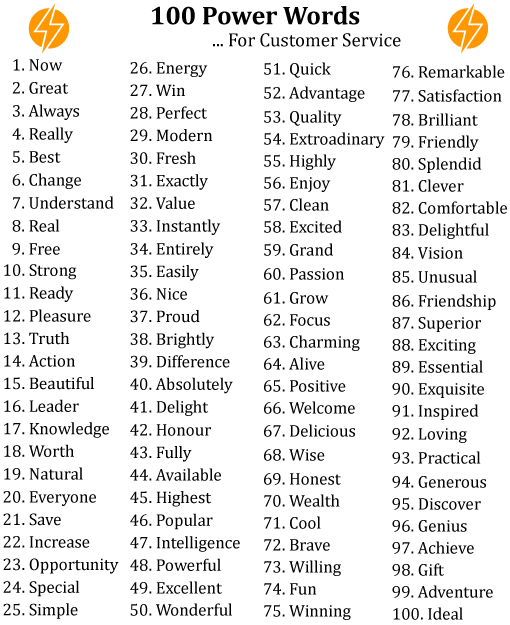
So, let’s take a closer look at the top power words according to this list, and share an example of how advisors can embed powerful words into their contact centre interactions and create phrases with power.
The Best Power Words and Phrases to Use in Customer Service
Here are 12 customer service words and phrases to use, alongside an explanation of why they can be used to great effect in customer service conversations and a contact centre specific example.
It is great to a reassure the customer of their query’s importance to your business and, to do this, it is good to provide them with a sense of immediacy. “Now” is a great power word to help you do so.
Example of this power word in customer service – “What I’m now doing to help you is…”
We’ve all written an email in which we have to request something of somebody, but worry that we sound a little too demanding. In customer service writing, this feeling is multiplied.
So, using “great” in a sentence like the example below can help to alleviate any concerns that you might have.
Example of this power word in customer service – “It would be a great help if you could…”
We want customers to feel confident in our ability to solve to solve their problem, so sometimes it is great to give them a guarantee, and “always” is the ideal power word for doing so.
Example of this power word in customer service – “What we can always do for you is…”
Sometimes, we want to emphasize one key point and the power word “really” is great for doing this.
For instance, if you have to present two key options to a customer but believe that one is much better for them than the other, this power word can be a useful tool – if used just like in the example below.
Example of this powerful word in customer service – “The option that I think is really great is…”
When a customer chooses to do business with us, we want to take away any hesitations that they may have. Using the word “best” helps to give the customer a little comfort that they are on the recommended plan/scheme.
Example of this power word in customer service – “Given your requirements, this is the best plan for you…”
This can be a great word to use with an upset customer , after you’ve let them vent and shown empathy, because you are highlighting to them that you are immediately going to do something to remove the source of frustration.
Example of this power word in customer service – “Let’s make a change ! As I solution, I suggest…”
7. Understand
We all recognize the importance of showing empathy in the contact centre and saying “I understand” can really help to lift a weight off the customer’s back.
It is particularly great if we draw on our own experiences beforehand, just like in the example below, to single ourselves out from the wider company and offer a more personalized experience.
Example of this power word in customer service – “I have experienced a similar problem recently, so I understand what you are saying.”
If you are listing a number of key features, options or benefits of a product, using the word “real” before introducing a key item on the list, like in the example below, can really focus the customer’s attention on this one specific point.
Example of this powerful word in customer service – “The real benefit of this option is…”
Everyone likes to get something for free. The word “free” therefore helps to spike our interest, as it signals that we, as the customer, might soon be offered something special.
Example of this power word in customer service – “What we do offer, as a free addition, is…”
“Strong” is a particularly good power word to use when describing something that the customer has done. It both helps to reassure the customer and emphasize that they have the “power” or control when it comes the final decision making.
Example of this power word in customer service – “I think that you’ve made a very strong choice.”
However, just because these are the most common powerful words, that doesn’t mean that there aren’t others that will work well in the contact centre space.
Two key examples of other power words that are well suited to the contact centre space include “something” and “willing”, as we discuss below.
11. Absolutely
There’s no ambiguity when using the word ‘absolutely’. It helps agents convey to customers that they can help with their query and gives them added confidence that they are in safe hands.
Example of this power word in customer service – “I absolutely can fix that for you today.”
Easily is a great power word for agents to include in conversations – particularly when explaining any next steps or processes customers need to follow. It helps to reassure customers.
Example of this power word in customer service – “This information can be submitted easily by follow the link I’ve emailed across to you.”
…And 8 Customer Service Words and Phrases to Avoid
When adding power wording into your agents scripts, you also need to consider removing words and phrases that risk doing more harm than good.
For example:
- “Your call is important to us.”
- “Our apologies for any inconvenience this may cause.”
- “Thank you for the feedback.”
- “Unfortunately, I can’t do that for you.”
- “Can you send a fax?”
- “I’m sorry you feel that way.”
- “Can I help you with anything else today?”
- “I’m sorry. I don’t understand.”
Say “Something” Not “Anything”
Research from linguists who work at Loughborough University found that, particularly in the medical or retail fields, when someone asks: ‘Is there anything else I can do for you?’ that sounds more negative than saying: ‘Is there something else that I can help you with?’

When someone asks: ‘Is there anything else I can do for you?’ that sounds more negative than saying: ‘Is there something else that I can help you with?’
As Sandra Thompson , founder of Exceed All Expectations , says: “ Not only does ‘something’ sound more positive, asking the question: ‘Is there anything else I can help you with?’ when you haven’t solved the original query, that’s not going to go down too well.”
So, if you have to ask this question, it is better to say: ‘Is there something else that I could help you with?’, as that will more likely lead to a more positive outcome.
The Word “Willing” Allows the Customer to Feel in Control
As a contact centre, we want to be speaking with calm customers who are fully in control of their situation. The power word “willing” can be a great tool to use to help them to get into this frame of mind.
Sandra adds: “ This is all to do with making the customer perceive that you are putting the control with them in making their decision.”
“So instead of saying: ‘Do you think you could…?’, it’s better to say: ‘If you’re willing…?’, as that changes the emphasis and people respond far more positively.”
3 Tips to Best Use Power Words in the Contact Centre
We’ve introduced the 100 most popular power words, highlighted how they can be used in customer service and shared a couple of contact centre specific examples. But we are not quite done yet!
Before you start adding these power words and phrases into your scripts or asking advisors to try them out for themselves, please think about the following three things.
1. Certain Power Words May Not Be Appropriate in a Formal Context
Power words are great to emphasize our points in a friendly, informal setting. But when things get serious, it can be better to forget about power words and get straight to the point.
When it comes to bad news, customers want every guarantee that you’re taking the matter seriously, so a formal tone is more appropriate.
As Sandra says: “ Generally customers prefer us to use informal language, as opposed to formal language, when we are talking to them. But if you’ve got a bit of bad news, being informal does not work.”
“When it comes to bad news, customers want every guarantee that you’re taking the matter seriously, so a formal tone is more appropriate.”
In these situations, we don’t want advisors to be thinking; “What power word should I add in?” We want the team to be fully focused on the customer.
2. Consider Which Power Words Echo Your Values
Our approach to customer service will likely depend very much on the values of our brand and therefore our customers. This should also be reflected in our use of power words and phrases.
Brands will often have series of words and phrases that their advisors are highly likely to use, in respect to their sector and values.
Sandra says: “ Brands will often have series of words and phrases that their advisors are highly likely to use, in respect to their sector and values.”
“As long as they are simple, understandable terms I think it’s only right that they are woven into all forms of communication, so we are providing the consistency that our customers expect.”
So, it’s great to be consistent with our use of power words and phrases, but – in terms of using brand-specific language – just beware of using cultural jargon, as it has the potential to confuse customers.
3. Use Power Words to Back Up Bad News
Sandra Thompson
While we should not use power words when delivering bad news, they can be very useful in terms of turning a negative situation around.
Sandra adds: “ If you have bad news, you should give it up front and follow that up with the good news, as this makes the conversation far more palatable for the customer.”
“To do otherwise would work against the laws of behavioural science, which suggest that the peak state of customer emotion should be a good feeling that people are left with.”
To find out more about the science behind customer emotions, read our article: 7 Steps to Evoke the Emotions You Want From Your Customers
Power words are great to use in all forms of conversation to evoke certain feelings from the people that we speak to. This also means that they hold great significance in the contact centre.
With this in mind, it can be good practice to sprinkle power words into contact centre scripts, as a trial first of all to assess their impact, or to coach advisors to use them effectively.
However, before we consider doing either of these things, we should first think about when it is appropriate to use power words and which words and phrases best echo our brand values.
For more tips and strategies to better use of language in the contact centre, read our articles:
- Replace These Negative Words With Positive Alternatives for Customer Service
- Customer Psychology: The Key to Better Contact Centre Conversations
- The Right Words and Phrases to Use on a Sales Call
Published On: 24th Jul 2019 - Last modified: 14th Mar 2024 Read more about - Skills , Customer Service , Featured Articles , Language , Positive words , Rapport , Sandra Thompson
Recommended Articles

Related Reports

- AI Content Shield
- AI KW Research
- AI Assistant
- SEO Optimizer
- AI KW Clustering
- Customer reviews
- The NLO Revolution
- Press Center
- Help Center
- Content Resources
- Facebook Group
8 Key Points: Discuss the Importance of Paraphrasing
Table of Contents
It is necessary to discuss the importance of paraphrasing because it is a skill that students need to write clear and precise writings.
When people write, they often use information from published sources to learn something new. This is an essential part of research. Paraphrasing is a useful tool to find new and unique ways to get a message across .
Plagiarizing a text that already exists while claiming to add new information is one of the worst things anyone can do. That’s why it’s important to learn how to make your content or text that isn’t copied.
This article will answer the question “What is paraphrasing?” and tell you why it’s important. Let’s jump in!

Can We Discuss the Importance of Paraphrasing?
Paraphrasing is the process of taking what the original author has written or said and putting it in your own words . Paraphrasing helps you write in your style and focus on the most crucial text elements.
If you use someone else’s idea in an essay, you must credit the person who came up with it.
To discuss the importance of paraphrasing is to show that creativity and originality are not all that make good writing.
Eight Important Reasons to Paraphrase
Without further ado, here are some of the top notch reasons why we paraphrase:
1. Enhances Memory Performance
People tend to forget a lot of things. Our brains can only hold so many memories before they start to discard old information to make room for new ones.
We write to make sure we don’t forget. Notes are taken in class to help us remember all the essential things we have learned. No matter how well we listen and understand, we are bound to forget some things.
The exciting thing is that we don’t write down what we hear word for word. Instead, we take notes by using our own words and phrases.
Our subconscious mind knows that altering phrases gets our brains active, therefore writing them in our way helps us remember them.
And that’s the divine power of paraphrasing. It helps us remember things that we might forget otherwise.
2. Organizes the Mind
A person needs to be able to figure out what he’s thinking to put it into words. But the words that come to mind aren’t always the best ones. It’s essential to change how we say things to make ourselves and what we mean more explicit.
Paraphrasing helps us write our thoughts more clearly. We organize our minds first to communicate our ideas and researched works in writing.
3. to Drive Home the Point
Students get involved in a lot of debates. Debating is a game of wordplay. If you use the right words correctly, it’s easier for you to win.
So, you need to know how to back up your argument with the right words. Precise, well-chosen terms give our line of argument more strength.
4. Acts As a Confidence Booster
We feel like we’ve done something good when we say things more clearly. This is true both when we speak and when we write. Making the notes in our way also makes us feel like we have more freedom to say what we want.
Writing well gives you a way to put your thoughts to rest and helps logical reasoning. You can use the rewording method to work on your writing and improve it.
5. Enhances Good Communication
Writing helps people talk to each other better. When you write, you can choose your words more carefully than you would if you just said them without thinking. If you keep using the restatement technique, you will notice a clear difference in how you talk.
A well-written CV, email, etc., can go a long way toward making sure your point gets across.
6. Decreases the Need for Quotes
Quotes are an excellent way to get specific information across, but too many of them can make text boring and repetitive.
Quotes may also indicate that one doesn’t understand the original document well enough. By paraphrasing a text, a writer cuts down on the number of quotes in their work, making it easier to read.
7. Puts an Argument in Its Proper Place
You can set the stage for your ideas when you paraphrase. When you rework another author’s words, you can guide the reader and frame your argument. So, a reader can see how an idea or concept has changed from one author or setting to another.
8. Shortens a Long Read
Paraphrasing is a great way to cut out fluff in a piece of writing into a few lines or pages. When paraphrasing, we go straight to the primary idea and aim and do not utilize extraneous language.
Paraphrasing is a means to summarize or re-create what has already been said and written. When done well, paraphrasing adds value to the original text and encourages deeper thought .

Pam is an expert grammarian with years of experience teaching English, writing and ESL Grammar courses at the university level. She is enamored with all things language and fascinated with how we use words to shape our world.
Explore All Paraphrasing Tool Articles
Advanced & effective paraphrase simplify tool.
The paraphrase simplify tool is designed to paraphrase and simplify your text effectively. This tool can be used for in-depth…
- Paraphrasing Tool
What Is a Paraphrase Citation?
When you paraphrase, many people think you don’t have to give a citation. Understand that because you have used someone’s…
Paraphrasing Vs Summarizing: What’s the Difference?
Paraphrasing and summarizing are two similar activities, but they are not the same. To understand the difference between paraphrasing vs…
The Best Paraphrase Tools: A Review
When it comes to paraphrase tools, there are so many to choose. This is why we decided some paraphrase tool…
The Best Paraphrasing Hacks From Students Themselves
Did you have a tough concept that you had a lot of trouble understanding? Paraphrasing helps with that. But it…
What are the Best Paraphrasing Tool to Download
Paraphrasing is the process of rewriting or rephrase a sentence without changing its meaning. A paraphrasing tool allows you to…
REVE Chat Version 4.0
Blending the strengths of IM and Live Chat
Upgrade your website to an instant messaging platform and beyond.
;)
30 Empathy Statements for Customer Service to Create Positive Impression
- Updated May 07, 2024
- Estimated Reading Time: 0
According to the Empathy Index , “Empathy is more important to a successful business than it has ever been, correlating to growth, productivity, and earnings per employee.”
Businesses can’t provide 100% effective solutions all the time. But what they provide is the best empathetic words in all the points of interaction to deliver a positive experience.
Beyond feeling good for your customer and boosting key business metrics, the importance of empathy statements in customer service can be good morale-boosting for your team.
Why Empathy Statements are Important?
Simply put, an empathy statement is defined as the act of understanding your customer’s experience in a way that you are sensitive to your customer’s thoughts and feelings.
Empathy statements for customer service show your ability to “walk a mile in someone else’s shoes”. Using the right phrases from the empathy word list can help so much in making customers feel that they are understood, and respected, and their feelings are validated.
Here are the importance of empathy statements in customer service and acting with compassion.
- Increased sales conversions – Truly understanding your customers’ needs means reflecting on their fears, desires, and pain points. In case your sales team fails to understand your customers, how can you expect them to explain how your products or services fit their lives? And here the power of empathy in business can be realized.
- Accelerated productivity and innovation – Customer support teams with strong empathy skills are more productive and innovative. It means if you want to increase efficiency and expand the number of problems you can solve for customers, you need to hire support reps with strong “soft skills.” They are familiar with the use of power words for customer service to show empathy.
- Expanded engagement and collaboration – When team members and managers express empathy and a willingness to act compassionately toward customers, it is a strong reason that companies would attract highly engaged individuals. Empathetic companies have better retention and higher morale among employees.
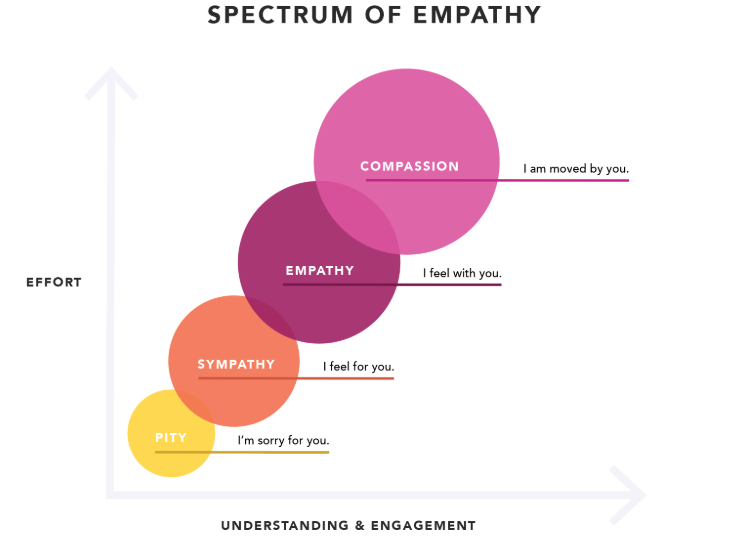
A great example of an empathy statement for customer service
Ryanair’s empathy success story after implementing their “ Always Getting Better” program. It helped to sort out many customer annoyances like hidden charges, unallocated seating, and carry-on baggage restrictions. Ryanair saw a net profit increase from €867 million to €1.24 billion (US$1.39 billion).
CEO Michael O’Leary famously remarked, “If I’d only known that being nice to customers was going to work so well, I’d have started many years ago.”
REVE Chat is a perfect fit here that helps you to be nice to your customers by understanding their needs or pain points and aligning service accordingly that fulfills their expectations.
It’s the right time to sign up for REVE Chat and explore how you can deliver a delightful experience to your customers.
How Do You Empathize With a Customer?
It is a crucial skill in customer service as it helps build rapport, trust, and satisfaction. Here’s an in-depth exploration of how to empathize with a customer:
1. Active Listening
This involves not just hearing words but understanding the underlying message. It’s about giving your full attention to the customer, which means eliminating distractions and truly focusing on what they are saying. Whether the interaction is in person, over the phone, or via chat, active listening is the foundation of effective communication in customer service. You should always maintain eye contact, nodding, and providing verbal cues like “I see” or “Go on” can signal to the customer that you are fully engaged.
2. Paraphrasing and Summarizing
These are tools that ensure mutual understanding. You can repeat back the customer’s concerns in your own words to confirm that you’ve correctly understood their situation but also convey to the customer that their perspective is valued. It’s a way of saying, “I hear you, and I want to make sure I’ve got it right.” This practice helps to avoid misunderstandings and clarifies any ambiguity in the customer’s communication.
3. Expressing Empathy
It’s about acknowledging their emotions and demonstrating that you care. Phrases like “I understand how frustrating that must be” or “I’m sorry to hear that you’re going through this” express empathy. This acknowledgment helps build a connection with the customer, making them feel heard and valued.
4. Put Yourself in Their Shoes
This requires imagining the impact of the situation on the customer’s life and emotions. Even if you haven’t experienced the same issue, recognizing the customer’s perspective and validating their feelings contributes to a more empathetic response. It shows that you acknowledge the validity of their emotions and concerns.
5. Use Positive Body Language
A genuine smile, maintaining eye contact, and an open posture convey warmth and interest. Avoiding defensive postures or gestures that might signal disinterest is equally important. Positive body language enhances the customer’s perception of your sincerity and commitment to assisting them.
6. Reflective Response
If a customer expresses frustration or disappointment, acknowledging those emotions directly is crucial. Reflect on the specifics of what the customer has shared and respond in a way that aligns with their emotional state. This not only shows understanding but also helps in building trust and rapport.
7. Offer Support and Solution
It’s about reassuring the customer that you are there to help and actively working towards a solution. Clearly communicate your commitment to resolving their issue and outline any steps that will be taken. You can deliver actionable solutions or a roadmap to give the customer confidence that their concerns are being taken seriously.
8. Follow-Up
After the initial interaction, reaching out to ensure the resolution has been satisfactory reinforces the idea that the customer’s satisfaction matters beyond the immediate issue. This step not only provides an opportunity to address any lingering concerns but also contributes to building a lasting relationship based on trust and reliability.
30 Empathy Statements for Customer Service With Examples
Expressing empathy is a good, natural, and honest way to promote relationships, both personally and professionally. The importance of empathy statements for customer service has a direct impact on creating a connection during a customer conversation. It requires your complete attention to the conversation and you are ready to take responsibility for them.
Your customer support team should be naturally empathetic, or they should be. That being said, nobody can be perfect all the time. We have compiled a few lists of empathetic statements and phrases to help inspire your team to craft even more empathetic responses across different scenarios. So, let’s explore 30 empathy statements for customer service with great examples that create a long-lasting impression.
Acknowledging Customer Frustration
Possibly, the best thing you can do is to acknowledge how your customer feels. When you try to connect with their pain or struggles, it makes them feel supported. It shows that you are genuinely putting effort into understanding their feelings.
When customers are frustrated, they just want to be heard attentively. They want validation that what they are going through is really very difficult.
Here are some empathy statement samples that can be used to acknowledge or validate consumer pain points .
1. “I am sorry you are going through this.”
Saying sorry when your customers are upset is a great way to start mending the relationship, and shows that you understand that they have been made to feel negative about your business.
By feeling sorry for what they have gone through, you create a sense of accord. It just not shows empathy for the unfortunate situation, but also assures them that their feelings are understandable.
2. “Oh! That sounds really challenging.”
Using these empathy words shows that you are personally involved in the conversation. This personal approach demonstrates a willingness to identify with the customer’s problems and build a trustworthy relationship.
Customers feel comfortable when they find you genuinely listening to their problems and appreciate your customer service etiquette .
3. “I can understand how that would be difficult.”
You can’t empathize with customers unless you understand their pains. Outstanding support is defined by genuine empathy and it is crucial to convey to your customers. Listen to them carefully to read their emotions and relate how they feel.
It shows your customer’s side.
Align with your Customers with Empathy Words
Going through difficulties can be a terrible experience for anybody. That is the reason why people share their struggles as if they are longing for a connection. They want someone to show interest in their story and understand how they are feeling.
The best way to connect with someone is not by talking, but by listening. Show you care by asking questions and showing a genuine interest in what they have to say.
Some examples of empathy statements to align conversations with customers:
4. “I can imagine what you must be going through.”
There are certain situations or incidents that we can relate to when we hear from customers. By using this empathy statement sample, you can support your customers and make them feel that they have been really going through a tough time.
When you align your statements along with your customers they open up explaining in detail. It helps you to understand your customer’s situation better and serve them better.
5. “I wish I could make it better.”
Not always you can provide a feasible solution to your customers but every time you can comfort them with your empathetic words. Listening to them patiently to what they have gone through is enough.
6. “It makes me really sad to hear this happened.”
When you show that you are equally sad by listening to what customers have experienced with your product or service, they feel that you are validating their problem and will be able to get a feasible solution.
Reassure your Customers with Empathetic Phrases
When customers reach out to you they look for concrete information or effective solutions. The customer service agents should have a full understanding to make the process of what happens next, clear to the customer. Do you want to learn more about customer service to show empathy to a customer in a better way? Find free customer service resources.
Reassuring the customers that the company will be striving to fix their issues creates a good impression and further builds brand rapport.
Here is the empathy statement sample below to show how to reassure customers.
7. “Thank you so much for notifying us about the issue.”
When you appreciate your customers for reporting about any product issue or complaining about any service, and assure them to act on it positively, it makes them feel happy that there will be no future hassle.
Giving credence to your customer complaints and valuing their feedback encourages them to reach you when they face any problem.
8. “We will get your issue resolved positively.”
Reaffirming to customers that you will provide a quick and effective resolution helps to strengthen the rapport between you and customers. When you use such statements, customers set expectations that you are putting effort into fixing the issue faster.
Using ‘we’ gives an idea to the customers that it is the effort of the whole team and their issue is set as a priority.
9. “You are totally right.”
Saying customers what they are saying is absolutely correct shows respect and empathy for their opinions. It also displays that you are considering your customer’s predicament.
Offer Gratitude for Honest Feedback
Generally, customers don’t share their opinions as it is not valued or given an empathetic response.
When someone chooses to open up to you, it shows they really trust you. It’s your job to honor that and respond with care. Offer gratitude to them for sharing their experience in terms of good or bad feedback will always benefit your company.
Let your customers know that you appreciate their sharing with you and acknowledge that it will be implemented. When you do this, it signals that you are a safe harbor for vulnerability.
Here are positive empathy statements for call centers that can help you to deliver a pleasing response.
10. “Thank you! We appreciate your honest feedback.”
Generally, customers do not prefer giving feedback due to many reasons. Customer feedback is the best way to improve your overall brand. When they provide their honest feedback, thanking them gives a very good impression.
When you use statements full of gratitude, it expresses that you are genuinely thankful for the feedback they provided.
11. “We are grateful for sharing your opinions with us. It will surely benefit our company.”
Companies that welcome customer feedback grow by increasing their loyal customer base. Feedback if looked into carefully brings golden opportunities for every business.
Expressing gratitude to the customers should be practiced whenever they reach out with complaints, feedback, or ideas.
12. “We appreciate the feedback you gave. Thank you for your precious time.”
Feedback covers the overall customer experience with your products or services. When you ask customers for feedback , it involves their time to provide it.
Always appreciate and thank them for spending time to share their feedback with you.
Sound Encouraging with Your Empathetic Statements
It is very important to be encouraging and motivating when your customers are going through a tough time.
Where one side shows customers to fix the issue or look at the brighter side; rarely helps although intentions are good, the other side is that you can’t be encouraging. You simply have to be mindful of how you approach it.
Instead of saying, “It will get better” or “Here’s what I would do,” remind customers that they are important to your business and you always value them.
Here are some good examples of empathy statements and phrases.
13. “You are really strong .”
Listening to the entire story and concluding that the customer is a strong person sounds encouraging. It makes the customer feel that you really admire the way he handled the situation.
Besides, using good empathetic words helps you to maintain your brand credibility.
14. “You are truly a fighter.”
Businesses can not replace the pain of the tough times customers have gone through, but certainly, they can empathize with them. Customer service agents must practice active listening to understand the entire customer journey.
Using empathetic words surely motivates them and you are there to help them in every possible way. Here are 15 acknowledgment statements in customer service that can be used to improve overall customer experience.
15. “I’m proud of you.”
When we say such empathy phrases to customers, it shows we find them strong enough to handle the tough times. It makes them feel you are supportive of them and are ready to help them in every way you can.
Use the Right Phrases for Defusing Tension with Customers
When it comes to calming irate customers, skillful use of empathy word lists by your agents is very important. By using good emphatic statements, you can tackle difficult or angry customers.
Here are the best empathy statements for customer service to be followed to calm down irate customers.
16.“May I arrange for an update call, at a time most convenient for you?”
Handling angry customers can be frustrating for call center agents still, they should be taken as seriously as possible, and formally empathetic language should be used at all times.
These positive empathy statement samples should be repeated at various points throughout the customer service conversations. It helps to diffuse the anger and reach out to the solution faster.
17. “Thank you so much for your patience, Sir.”
When customer service agents encounter a furious customer, the first thing is to offer some words of empathetic reassurance. It helps in reducing their anger significantly. Saying thank you for being patient can also diffuse the situation a bit.
18.“For the quickest resolution, I would request you to…”
It is important to remember that, regardless of how unpleasant he or she might be as a person, each and every one of your customers is an essential source of revenue for your business.
When it comes to handling stressful situations, properly using words and phrases can go a long way in creating a positive service experience.
Follow Up with Customers with Good Empathy Statements
One of the key aspects of customer service is following up with customers. When you make follow-ups, it helps to comfort them with the knowledge that their issue is being treated. The customers are updated about the process and they stay positive about the whole circumstance.
Here are some examples of positive acknowledgment statements for a call center that show that you commit to and follow up with customers.
19. “I will get in touch with you we have the latest update”
When you commit to customers, make sure that you keep your word as it helps to establish trust between the company and the customer.
Keeping the promise helps in building long-standing relationships.
20. “We assure you that fix your issue. You enjoy your holidays. I will contact you shortly”
When you acknowledge your customer’s personal holidays, it allows you to add a personal touch to your interaction.
Basing your services across your customer’s schedule demonstrates an empathetic approach.
21. “Please let us know if you have additional questions.”
Encouraging future contact with your customers helps show your company’s commitment to strengthening your customer relationship and fostering advancement in the rapport between the customers and agents.
Provide a Sense of Urgency with the Right Empathy Statements
Providing a sense of immediacy with proper phrases is as important as customer inquiry for businesses. These positive acknowledgment statements are more important for irate customers. Agents can use the right words and reduce customer anger.
Here are the best empathy statements for irate customers that show a caring approach.
22. “I appreciate you reporting to us about the problem. We will look into it immediately”
At times customers identify some issues that businesses have overlooked. When customers reach out to you, highlighting such issues, you should assure them that the issue they have raised is right.
Using empathy phrases that appreciate them will allow the customers to believe that all their efforts are valued by your company.
23. “I have identified the problem.”
Conveying the advisor’s experience in handling calls of this nature provides the customer with a strong indication of the ability of the call center professional to find a swift solution to the query.
24. “I will be helping you with…”
When you use such a positive empathy statement for customer service, it shows that you are taking control of the situation, which allows the customer to feel as if the problem has been handed over to the agents.
It also shows that you are personalizing the matter and making the customer feel special.
25. “The issue will be fixed completely in two business days.”
Certain issues can not be resolved in a day. When customer service agents provide a relevant timeframe for query resolution, the agent must make customers feel relaxed.
When you provide an estimated time for resolution, the customers are in a positive mindset of getting the feasible solution after a day or two.
Building Strong Customer Relationships
There are times when customers are not convinced by the answers you give them. Starting an empathetic conversation is the key to handling such situations and building strong customer relations.
But how do you empathize with a customer in such a scenario?
Here are examples of empathy statements for customer service that will help to quell such issues and rebuild customer trust in your service and business processes.
26. “We value customers who provide their feedback. I assure you to share it with the respective team.”
When you exhibit that you value customer feedback and take proactive actions to imply it, customers tend to share honest feedback that turns out to be golden opportunities for your business.
Describing the process of sharing feedback across the right team and departments shows your well-defined process for handling customer concerns.
27. “I have encountered a similar issue, so I understand quite better. Let me check the best way I can help you with.”
One of the best ways to use a positive empathy statement is by sharing their own experiences with the customers. Sharing such things with customers signals that it is not only he but many who have faced such an issue.
The customers feel comforted that they will be getting a solution soon.
Wrapping up the Conversation
While closing the conversation, support agents must maintain a respectful tone and empathetic attitude so that customers feel comfortable voicing more concerns and stay satisfied with the service they have received.
Here is an empathy statement sample that can be used while signing off with a customer and staying empathetic.
28. “Is there anything else that I can help you with Sir/Madam?”
When you use phrases and rely on customer service script sample to assist your customer concerns further it shows there is no time limit in the job description of your agents and your business has no limitations on providing great customer service .
29. “Your satisfaction is our prime goal. Have we discussed everything that you wanted?”
Conveying customers about your business objectives and showing that you are always on your heels to support them helps to conclude with a sustained empathetic approach.
Using the right words from the empathy word list such as our customer satisfaction as the prime goal summarizes the collaborative culture, which is the foundation of empathy.
30. “Thank you for choosing us. Have a good day.”
From all the available options, your customers have chosen you for some reason. Let them know, you truly appreciate their choice to work with your business.
Expressing your pleasure in terms of interacting with customers, serving them, and wishing them a good day makes customers delighted and they will be comfortable in reaching out in the future.
Importance of Empathy Statements in Customer Service Can’t be Ignored
Most of the customers’ decisions are largely emotional rather than logical. That’s what makes empathy a great tool to help show customers that you are on their side.
With the right use of empathy statements for customer service, your clients will feel a strong bond with you and your company. And that’s how there is an increase in customer lifetime value (CLTV) and loyalty towards your business.
Believe it or not, you can not always provide the right solution at the right time, but you can always deliver a human connection. The empathy phrases suggested above can handle customers effectively across various situations.
REVE Chat, the omnichannel customer engagement platform provides you advanced tools along with chatbots to enhance your customer communication by understanding their pain points. Sign up with REVE Chat and explore how you can deliver a better customer service experience.
Start a 14-day free trial, no credit card required!
Snigdha Patel
Snigdha Patel is a customer experience researcher, author, and blogger. As part of REVE Chat, she focuses on helping organizations maximize customer experience using omnichannel messaging and conversational AI.
She creates contextual, insightful, and conversational content for business audiences across a broad range of industries and categories like Customer Service, Customer Experience (CX), Chatbots, and more.
Serving as the lead content strategist, Snigdha helps the customer service teams to leverage the right technology along with AI to deliver exceptional and memorable customer experiences.
Being a customer service adherent, her goal is to show that organizations can use customer experience as a competitive advantage and win customer loyalty.
Leave a Reply Cancel reply
Your email address will not be published. Required fields are marked *
REVE Chat Blog
Stay updated with the latest trends and ideas we share, 70+ different ways to say “thank you for your patience”.
"Thank you for your patience" is a powerful phrase in customer service. It’s used to express gratitude for patience. Service...
How to Say Sorry for a Late Response? Examples & Templates
Have you ever been so busy you forgot to answer someone? It happens to everyone. Isn’t it? Whether it's an...
What is a Support Ticket- A Comprehensive Guide
It's very common for customers to face problems with any product or service a company offers. That's why having a...
Related Posts
Signup for REVE Chat on any annual plans at these jaw-dropping prices today and start engagaging your customers across all channels. Limited Time Only.
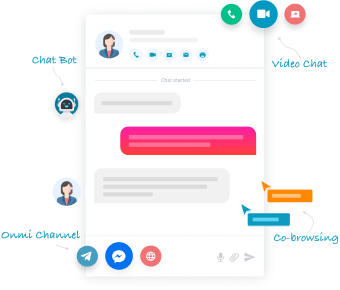
The AI enabled live chat platform to help your business win and nurture customers across messaging channels.
Join 446,005 businesses who are already engaging up
Get Started

- Respond to customer queries in real time
- Qualify leads automatically
- Reduce the number of support tickets
- Deliver better conversational experience
- Boost customer satisfaction
- 11 Facebook
- More Networks
Showing empathy is crucial for the success of any customer service team. It emotionally connects you with your audiences. Use our smart customer service platform to give your customers a Wow experience.

Say No to customer waiting times, achieve 10X faster resolutions, and ensure maximum satisfaction for your valuable customers with REVE Chat.
Paraphrasing
What is Paraphrasing?
Paraphrasing is repeating back your understanding of the material that has been brought by the client in your own words. A paraphrase reflects the essence of what has been said.
We all use paraphrasing in our everyday lives. If you look at your studies to become a counsellor or psychotherapist, you paraphrase in class. Maybe your lecturer brings a body of work, and you list and make notes: you’re paraphrasing as you distil this down to what you feel is important.
The Power of Paraphrasing:
- The speaker feels heard.
- Helps the listener to adjust frame of reference.
- Highlights areas of high importance.
- Acts as an invite to explore deeper.
- Can indicate an end to the current discussion.
How Paraphrasing Builds Empathy
How does paraphrasing affect the client-counsellor relationship? First of all, it helps the client to feel both heard and understood. The client brings their material, daring to share that with you, and you show that you’re listening by giving them a little portion of that back – the part that feels the most important. You paraphrase it down. If you do that accurately and correctly, and it matches where the client is, the client is going to recognise that and feel heard: ‘Finally, somebody is really listening, really understanding what it is that I am bringing.’
This keys right into empathy, because it’s about building that empathic relationship with the client – and empathy is not a one-way transaction. Carl Rogers (1959, pp. 210-211) defines ‘empathy’ as the ability to ‘perceive the internal frame of reference of another with accuracy and with the emotional components and meanings which pertain thereto as if one were the person, but without ever losing the “as if” conditions’. In other words, we walk in somebody’s shoes as if their reality is our own – but of course it’s not our reality, and that’s where the ‘as if’ comes in. I’ve heard this rather aptly described as ‘walking in the client’s shoes, but keeping our socks on’!
Empathy is a two-way transaction – it’s not enough for us to be 100% in the client’s frame of reference and understanding their true feelings; the client must also perceive that we understand. When the client feels at some level that they have been understood, then the empathy circle is complete.
For example, if you watch a TV programme in which somebody achieves something that is really spectacular, you may find yourself moved for this person. You’re almost there with them on this journey, and as they’re receiving their award or their adulation, and the audience is clapping for what they’ve done, you may even be moved to tears. But the person on the TV cannot perceive your reaction – the empathy is empty, because it’s one-way.
So empathy is effective only if your client feels heard and understood – i.e. they sense that empathic connection. Using paraphrasing is a way of completing the empathy circle – a way of letting them know that we see and hear them.
Other Benefits of Paraphrasing
Paraphrasing also highlights issues by stating them more concisely. This is focusing down: it invites the client to go and delve deeper into part of what they have said. We can also use paraphrasing to check out the accuracy of our perception as a counsellor.
Below is an example of my use of paraphrasing to clarify my understanding of what was brought. This shows how paraphrasing affects the therapeutic relationship; because the paraphrase fits well for the client, she feels heard and understood. As this happens, the material deepens.
I really have a battle with doing things for the impression that others will have of me, or the approval that I will get from other people for what it is that I do. So much so that I will very often override myself, my family, so that I can gain the acceptance, I guess, of other people, whether friends, family or clients in a work situation. I will always favour what the action would be that would gain that acceptance, that would not bring up any sort of confrontation or maybe have a conflict situation arise from it.
So, I guess, I’m eager to please, wanting to make sure that all things are well and smooth – and that I’m liked and accepted with whatever the transaction or situation may be.
Counsellor:
As you’re saying that, it really feels like a lot of hard work. A lot of hard work, pre-empting whatever it is that they would have expected of you, and then ‘sacrificing’, I guess, is a word that came up for me – sacrificing your own wants/needs to be able to meet what you perceive is expected of you. Have I understood that correctly?
Yeah, the word ‘sacrifice’ really captures the feeling that comes up for me when I sort of reflect and look over that kind of situation. So often, I will sacrifice my own wants and my own desires…
In this example, the client really resonated with the word ‘sacrifice’, which the counsellor introduced as a paraphrase; she really felt understood. And it’s interesting to note that throughout the rest of this stimulated session, the word ‘sacrifice’ became almost a theme.
Another paraphrase in this example was ‘hard work’. Although the client hadn’t used this phrase herself, she was presenting visually as weighed down. Her shoulders looked heavy as she was bringing the material. So the counsellor was paraphrasing, not only the words of the narrative, but digging deeper, looking for the feelings and paraphrasing the whole presence of that client within that relationship.
Listening for ‘the Music behind the Words’
Here is another example of paraphrasing, from the same skills session. Try to see if you can hear, as Rogers would put it, ‘the music behind the words’, where the counsellor looks deeper than just the words the client is bringing, paraphrasing back their whole being.
Out of my own will or my own free choice, I would put that aside and favour what would be accepted – or what I think someone else would rather I do. And sometimes it’s hard. It leaves me with a situation of not knowing if they actually really realise what it is that I sacrificed, that I’ve given up, so that it can fall into what I think they would prefer in that situation.
It feels confusing to you in that situation of whether they even perceive what it is that you are sacrificing, what you’re giving up. That it almost feels like you’re giving up part of yourself to match what you think they may want or need from you. And I kind of got the feeling, as you were saying that you wonder if they even see that.
Yeah. As I was sort of verbalizing and talking through that, I actually realised that even within that sacrifice, it’s all my perception of what I think they might want me to do. And just saying that is actually a bit ridiculous. Because how am I to know what it is that they want or need to do? So here I am – disregarding my own desires, for lack of a better word – to do something I assume someone else would want me to do instead.
I thought it was really interesting that this client started off in what felt to me like an external locus of evaluation. She was confused, and wondering whether the people she refers to understood what she was giving up to meet their perceived expectations. Immediately after the counsellor’s paraphrase, this client experienced a moment of movement from an external to an internal locus of evaluation, where she realised it was all about her own perceptions and responsibility. In this way, she went from being powerless to having the power to change this situation.
Next Steps in Paraphrasing
Paraphrasing is so much more than just repeating the client’s words back to them using your own words. Although it might feel very simplistic – and there’s often a tendency to paraphrase the narrative/story that the client brings, rather than their feelings/process – there’s so much more to it than that and so much deeper that we can go. There’s real power in paraphrasing.
I suggest that you:
- Practice active listening and paraphrasing in your day-to-day life.
- Practice paraphrasing in your own stimulated skills sessions.
- Try to look for the full person when paraphrasing, e.g. not just the client’s words, but also their body language, facial expressions, and way of being within the counselling relationship.
- Record these sessions (with your peer’s consent) and listen back to them.
- Speak to your peers about paraphrasing.
- Evaluate each other’s skills and explore how you might paraphrase more effectively.
- Look whether you’re getting empathic connection within your paraphrasing.
- Search out moments of movement when you paraphrase.
- Ask how paraphrasing affects both the client and you, as a counsellor.
Paraphrasing is definitely something that should be debated. I hope that this chapter will encourage you to go out there with a new passion for – and a new way of looking at – paraphrasing!
Alternatives to Questions
What else can we use when we’re not sure what exactly a client means? For example, if a client was speaking about his brother and father, he might say: ‘I really struggle with my brother and my father. They don’t get on, and at times he makes me so angry.’ Who does the client mean by ‘he’: the brother or the father? Not knowing who makes him angry means I cannot be fully within the client’s frame of reference.
I could ask: ‘Sorry, just so I can understand, who it is that you’re angry at – your father or your brother?’ This risks ripping the client out of that emotion (the anger). Instead, we could use reflection: ‘He makes you so angry.’ This invites the client to expand on what he has said. He might say: ‘Yes, ever since I was a young boy, my dad was always…’ In this case, I didn’t need to ask a question – we’re still in the feelings, and I’ve got what I needed in order to be fully in the client’s frame of reference.
Of course, the client might not reveal the information I need in his answer – for example, if he responded to my reflection: ‘He does. He makes me really angry – in fact, so angry that I don’t know what to do about it anymore.’ In that case, I would still need to put in a question: ‘Is this your dad or your brother that you’re referring to?’
Rogers, C, 1959. ‘A Theory of Therapy, Personallity, and Interpersonal Relations, as Developed in the Client-Centered Framework’, in S Koch (ed.), Psychology: A Study of a Science (Vol.3), New York: McGraw-Hill, 184-256.
© Counselling Skills - Privacy Policy • Refund Policy • Contact Us

Putting the “Customer” in Customer Call Centers
A nyone who has run a call center knows that it’s a lot more than just folks sitting around making calls or waiting to receive them, and it certainly involves more than just a simple phone. At least it should if you want to make the most out of the experience, both for yourself and for your customers. That’s because technology – due to advances in communication and the integration of phones with the internet – has come such a long way that not only do you have no excuse to do more, but you’re simply making it harder on yourself if you don’t.
So whether you have been in the business for decades or you’re just taking your first steps into the world of running call centers, it can behoove you to think about all the new technologies that you may not be taking into account, however, when used correctly, they have a positive impact on the call center metrics that matter. We grouped them into three loose “baskets”: help for the customer, help for employees, and help for managers. Let’s go!
Help for Your Customers
It does not take someone with years of experience to know that customers are not always happiest when talking to call center representatives. They either need to do something un-fun – pay a bill, lodge a complaint – or, if you are calling them, they may have had their day interrupted. This is not just qualitative - a study from Gartner found that ¼ of customer loss is due to poor customer service.
And don’t count on low prices saving you; they overrule bad customer service in the mind of a prospective client only about 30% of the time . It’s important to make the process as smooth and as easy as possible. For starters, that means investing in a communications company that can provide nearly 100% uptime. You do not want your calls to drop or servers to simply stop working in the middle of a call; that will guarantee customer frustration.
Once the calls are underway, there are more ways to help make the entire process a smooth one for your customers. While they are on hold, use pre-recorded custom messages that they can hear while they wait. This used to be cumbersome, requiring customers to listen to a boring robotic voice. But now you can use extremely lifelike AI with easily accessible services – ElevenLabs or Murf AI, to name a few – or, you can simply record yourself in seconds- Quoted by Ben Ajenoui from SEOHERO.io .
Not only does this mean that you can let customers know new information without your employees having to tell them once the call starts (saving time), it can also be a time to answer frequently asked questions that callers may have. If this answers a customer’s question, it can end calls before they happen, saving everyone time!
But if you can’t do that, then at least make it easy for your customers to get to where they need to go. Efficiently organized call queues , when combined with aforementioned recorded messages, can keep things running smoothly so that there are no 50-call pileups in which the ringing just goes on endlessly. " Call center's goal is to transform every call into a positive outcome. By organizing call queues more efficiently and integrating smart messaging, we can make sure that no customer is left waiting unnecessarily." - Dmitri Lepikhov , CEO of MightyCall.
Help for Your Employees
It’s important to keep in mind your own employees as well. The easier it is for them, the more efficiently – and pleasantly – they can make calls. One of the most exciting tools to come out of the 21st century on this front is AI - that’s right, artificial intelligence along with digital commerce . While many people think of things like ChatGPT, AI has been used in all sorts of inventive ways. Three that relate to our purposes are call transcription, call summary, and skill-based call routing:
● Call transcription - is a smarter way of transcription, using machine learning to be able to more accurately transcribe calls (automatically too). This helps to eliminate the often frustrating “Audio unclear” - type blanks that often appear in traditional transcription software.
● Call summary - is a feature, in which AI tells you the most important parts of the call, meaning your employees can get the gist in a glance instead of reading an entire call transcript.
● Skill-based call routing can also help your employees greatly. Some call center employees, especially those who have been there a while, may have become particularly skilled in certain areas of customer service; maybe someone is very good at helping to pay bills, while others are good at tracking down lost packages.
Getting the call to who can best help the customer can make the entire process easier on your employees, helping them to use their learned skills in a more effective way. Making sure that they get calls related to those areas can help you provide even better levels of caller engagement.
Help for Your Managers (And Perhaps For Yourself!)
Then, there are the managers (perhaps you!). You have to be able to understand what is going on inside your own call center; if you do not, things could easily go awry. For a general overview, be sure to get a phone service that allows for extended call analytics. These give you a broad view of everything happening in your call center:
● How many calls are answered?
● How many are missed?
● How long do they last?
● Who is talking the most?
● Who is talking the least?
● Where are the calls coming from?
If you can think of a statistic, it’s probably there (and there are probably many you would not even think of!). If you pair this with call recording, which allows you to record all calls, you can listen to what has already been said in order to have a truly comprehensive view of your operations. Sentiment analysis is particularly interesting on this front; this can help you see how calls are going when it comes to agent performance and can be useful for training.
But sometimes, you have to get involved yourself. This is where tools like live call monitoring come in. These allow you, or other managers, to reach into the call yourself. Some, like listening, are just that: they allow you to listen in on ongoing calls without disturbing anyone.
Others, like whisper, allow you to speak to your employee without the other person knowing. Some allow you to simply jump into the call, with the option of removing your employee and taking the call over yourself. Combined, these all give you a useful multi-tool that can help you smooth out any wobbly conversations.
It’s also of course important to remember that these baskets are not so clear-cut. As you can likely see, all of these different features can help in all baskets. A manager can be helped by informing their callers about new sales, and employees can be helped by having their manager be able to jump in if they need to quickly get off the line for whatever reason. The point of having these features is that they give YOU the tool to run your call center most efficiently, the way that most benefits you.
Don’t Be Afraid to Change with the Times
There is no surefire way to run a call center. There is no absolute list of do’s, and absolute list of don’ts. But we are pretty confident in saying that you should not limit yourself to 20th-century technology when there is cheaper, effective, modern technology available- Says Martha Jones from InspiringLADs.
Do yourself, your employees, and your customers a favor: look into internet-based calling solutions for your company. You won’t just be putting new technology into your workplace - you’ll be putting the customer back into customer call centers.

Advertisement
Supported by
political memo
Trump Has Long Been Known as a Micromanager. Prosecutors Are Using It Against Him.
Witnesses have described the former president monitoring the minutiae of his business, a portrait prosecutors are drawing to help convince the jury that he couldn’t have helped but oversee a hush-money payment to avoid a damaging story.
- Share full article

By Jonah E. Bromwich , Maggie Haberman and Jonathan Swan
At Donald J. Trump’s Manhattan criminal trial, his lawyers have insisted he had “nothing to do” with any of the felony charges against him.
But testimony from prosecution witnesses over the last several weeks has called that argument into question, underscoring that Mr. Trump can be obsessive about two all-important aspects of his work: Anything having to do with the media, and anything having to do with his money.
The 34 documents at the heart of the prosecution’s case relate to both obsessions.
The Manhattan district attorney says Mr. Trump orchestrated the disguise of 11 checks, 11 invoices and 12 ledger entries to continue the cover-up of a damaging story, paying his former fixer $420,000 in the process. And the testimony about Mr. Trump’s management style could play a central role as prosecutors seek to convince the jury that there is no world in which Mr. Trump was not tracking the outflow of cash from his accounts.
The prosecutors’ strategy illustrates the risk of a criminal trial for Mr. Trump, one of the most famous men in the world, whose character and habits are familiar even to those who have not tracked his every move. The Manhattan district attorney’s office has accused him of orchestrating the falsification of the 34 documents to cover up a hush-money payment to a porn star, Stormy Daniels.
David Pecker, the former publisher of The National Enquirer and the trial’s first witness, worked with Mr. Trump for decades, the two men trading favors as each sought to make headlines. Asked about Mr. Trump’s qualities as a businessman, Mr. Pecker described him “as a micromanager from what I saw,” adding that “he looked at all of the aspects of whatever the issue was.”
The prosecutor questioning Mr. Pecker next asked about Mr. Trump’s approach to money. “He was very cautious and very frugal,” Mr. Pecker replied.
The prosecutors have a mountain of documentary evidence, but none of it directly links Mr. Trump himself to the scheme. Yet witness after witness has emphasized some of the former president’s most famous characteristics — some of which Mr. Trump himself has promoted for decades — eliciting a portrait of a man who prosecutors contend could not have helped but oversee a hush-money payment to avoid a damaging story.
It is unclear whether jurors will accept that narrative. Only one witness, the former fixer, Michael D. Cohen, is expected to testify to having direct knowledge of Mr. Trump instructing his underlings to falsify documents. And one employee, Deborah Tarasoff, has said that Mr. Trump did not oversee her work closely, testifying that he typically acted through at least two layers of middle management.
But the courtroom has already heard, from old friends and former employees, about the way Mr. Trump’s tendencies informed the culture of his company, the Trump Organization, where he first honed his management style.
Hope Hicks, a former spokeswoman for Mr. Trump, described it in her testimony as a “very big and successful company.” But she noted that it was “really run like a small family business.”
“Everybody that works there,” she said, “in some sense reports to Mr. Trump.”
Ms. Tarasoff’s former manager, Jeffrey McConney, told a story that may have pleased prosecutors. He said that early in his career at the Trump Organization, he had walked into the boss’s office and Mr. Trump — in the midst of a phone conversation — had told him: “You’re fired.”
Once off the phone, Mr. McConney said, Mr. Trump had taken it back. But he had warned his new employee to watch the accounts closely, noting that the “cash balances went down last week.”
“He said, ‘Now focus on my bills,’” Mr. McConney recalled. “It was a teaching moment. Just because somebody is asking for money, negotiate with them, talk to them.” Don’t just hand the money over “mindlessly.”
Mr. McConney’s testimony was corroborated on Tuesday by an unusual witness: a past version of Mr. Trump himself.
Sally Franklin, a top editor for Penguin Random House, was called to the witness stand to read aloud passages from two of Mr. Trump’s books in which he described himself as a fastidious custodian monitoring the minutiae of his business.
“I always sign my checks, so I know where my money’s going,” he wrote in one of the excerpts read aloud in court. In another, Mr. Trump boasted of cashing a check for 50 cents, sent by Spy magazine as a prank. (Spy Magazine sent Mr. Trump minuscule checks in decreasing amounts, the lowest being 13 cents; none was for 50 cents.)
“They may call that cheap; I call it watching the bottom line,” he wrote in the book. “Every dollar counts in business, and for that matter, every dime. Penny pinching? You bet. I’m all for it.”
Prosecutors hope that it will be hard to imagine that author parting with $420,000 without good reason.
In interviews, former aides said that while Mr. Trump’s focus did not apply to everything, he was attuned to any element of his business or persona that the public might see, from visuals to advertising copy to press statements.
Jack O’Donnell, a former Trump casino executive, recalled Mr. Trump, late one night, admonishing a maintenance worker who was polishing the marble floors at one of the casinos — Mr. Trump told the worker he was using the wrong chemical. Alan Marcus, a former consultant for the Trump Organization, described Mr. Trump providing feedback on the language of a television commercial opposing a tunnel project by a casino rival in Atlantic City, and on taking the spots down when they became controversial.
Barbara Res, a former top Trump Organization executive who oversaw some of Mr. Trump’s most prominent construction projects, including Trump Tower, said that the boss didn’t have any real knowledge of high-rise construction before that project. But she said that when it came to specific superficial details, he often sought to impose his will.
That included insisting, in spite of building code requirements, that he didn’t want buttons in Braille in his elevators. “He said, ‘We won’t have handicapped people living in Trump Tower, so we don’t need that,’” she recalled. The architect working on the project overruled him.
Mr. Trump himself described this tendency in another book excerpt read in court, writing: “When you are working with a decorator, make sure you ask to see all of the invoices. Decorators are by nature honest people, but you should be double-checking regardless.”
Ms. Res described a culture where Mr. Trump’s desires were so well known that people would often do things to please him without him saying a word, paraphrasing a version of what Mr. Cohen has said.
“We knew Trump so well, he didn’t have to say anything, we knew what he wanted,” Ms. Res said. “I never did anything illegal and I stopped him from demolishing a building without a permit. But others did.”
There have also been indications during the trial of Mr. Trump’s tendency to insert himself — to micromanage — when the stakes are high. Ms. Hicks, the former spokeswoman, told a story that hinted at her former boss’s interest in the coordination of hush-money payments, even if he did not deign to involve himself directly.
At that time, Mr. Trump, famously, did not text. But Ms. Hicks did. On the stand, she described a text message that she had sent to Mr. Cohen on Nov. 5, 2016, days before the presidential election. Something had prompted her to ask Mr. Cohen for Mr. Pecker’s phone number — despite already having contact information for the publisher.
“I have it,” she told Mr. Cohen apologetically. “But Mr. Trump thinks it’s the wrong number.”
Jonah E. Bromwich covers criminal justice in New York, with a focus on the Manhattan district attorney’s office and state criminal courts in Manhattan. More about Jonah E. Bromwich
Maggie Haberman is a senior political correspondent reporting on the 2024 presidential campaign, down ballot races across the country and the investigations into former President Donald J. Trump. More about Maggie Haberman
Jonathan Swan is a political reporter covering the 2024 presidential election and Donald Trump’s campaign. More about Jonathan Swan
Our Coverage of the Trump Hush-Money Trial
News and Analysis
Ahead of Michael Cohen’s testimony on Monday, Justice Juan M. Merchan told prosecutors to keep Mr. Cohen from speaking about the case .
Several witnesses have mentioned Keith Schiller , Donald Trump’s bodyguard, during their testimony. Where is he?
Custodial witnesses, who have discussed FedEx labels, Sharpies and stapling protocol, have made for little spectacle in the trial. But they’ve provided basic information about the documents at the heart of the case.
More on Trump’s Legal Troubles
Key Inquiries: Trump faces several investigations at both the state and the federal levels, into matters related to his business and political careers.
Case Tracker: Keep track of the developments in the criminal cases involving the former president.
What if Trump Is Convicted?: Could he go to prison ? And will any of the proceedings hinder Trump’s presidential campaign? Here is what we know , and what we don’t know .
Trump on Trial Newsletter: Sign up here to get the latest news and analysis on the cases in New York, Florida, Georgia and Washington, D.C.

COMMENTS
Paraphrasing is one of the most important steps towards a speedy resolution. ... Inbound vs. Outbound Call Centers: Choose the Right Strategy. April 17, 2024. Customer Service vs. Customer Support. March 1, 2024. 6 Top-Rated AI-Enabled Tools for Customer Service. February 7, 2024.
2 How to paraphrase effectively. To paraphrase effectively, you need to follow some basic steps. First, you need to listen carefully to what your customer is saying, and to avoid interrupting or ...
Call centers use scripts for several reasons. Scripting allows you to control messaging and ensure agents are providing a consistent service experience to every customer. Scripts help move calls along efficiently. And they can reinforce your brand as a helpful listener. But different styles of scripts work best in different situations. Here is a comparison of two common styles of scripts and ...
Paraphrasing in a call centre or customer service setting is restating a customer's issue or question with new words or phrases while keeping the same meaning to demonstrate you understand what they are telling or asking you. It is often used to demonstrate active listening skills, one of the most important tools in customer service.
By paraphrasing, you can curate credible and well-developed documents, and arguments. But there's more to paraphrasing than the final result, the process of paraphrasing engages your ability to learn actively, write well, and communicate creatively. Amirah Khan. March 22, 2022. Paraphrasing allows you to share another's ideas in your own words.
Mastering the 7 C's of call center communication is essential for delivering exceptional customer service. By focusing on clarity, courtesy, confidence, consistency, customization, collaboration ...
Sometimes you want a call center script that agents can read verbatim. This works well when calls are generally short and transaction-based, or, for example, when a disclaimer needs to be read. Advantages of a verbatim script: No need for agents to deviate from the script. The call center can control messaging and branding.
3. Use Powerful Words. There are many subtle power words that can be used in customer service, such as imagine, discover, guaranteed, safe, free, new, and proven. These can all deliver results in terms of making the customer feel good about the product/service that is being offered to them.
Let your customer finish speaking before you begin speaking, and always maintain a professional and calm tone of voice. 4. Call the customer by their name. Ask the customer their name and pronounce it correctly. This communicates respect for the customer and lets them know that they are important. 5. Go the extra mile.
Mastering conversational support is a non-negotiable skill in customer service and call centers. Knowing the right etiquette — whether on the phone with a customer or during a cobrowsing session with them — can influence CSAT scores, significantly sway a customer's perception of a company and, in turn, influence their loyalty.. 1 in 6 shoppers will back out of purchase due to a bad ...
5 examples of active listening for call center reps: Building trust and rapport. Demonstrating concern over issues or requests. Repeating and paraphrasing the problem to show you understand and hear the customer. Nonverbal cues for in-person or video communications, such as eye contact and leaning in. Verbal affirmations after the customer ...
By employing strategies such as active listening, clear and concise language, empathy, and effective use of technology, contact center agents can enhance their communication skills and create ...
Learn how to use these three statements to display politeness and compassion in customer service and form the bedrock of call center etiquette. Find out the benefits of paraphrasing and how to use it in a customer service script.
By committing these five key active listening skills for call center agents, it's possible to improve each encounter and sharpen your natural emotional intelligence skills. 1. Stay in the moment, and listen only to the caller. One of the hardest parts of active listening on the phone is the ability to stay focused on the caller in the moment ...
Paraphrasing is repeating in your words what you interpreted someone else to be saying. Paraphrasing is powerful means to further the understanding of the other person and yourself, and can greatly increase the impact of another's comments. It can translate comments so that even more people can understand them.
with my little experience in the call center industry, the use of positive words are very important. the concern here however is, knowing when, where and how to use them. for me, knowing your caller is very important.i.e if the caller is an intellect or an average person. for an intellect, the words above may be an exaggeration but to an ...
1. Now. It is great to a reassure the customer of their query's importance to your business and, to do this, it is good to provide them with a sense of immediacy. "Now" is a great power word to help you do so. Example of this power word in customer service - "What I'm now doing to help you is…". 2.
By paraphrasing a text, a writer cuts down on the number of quotes in their work, making it easier to read. 7. Puts an Argument in Its Proper Place. You can set the stage for your ideas when you paraphrase. When you rework another author's words, you can guide the reader and frame your argument.
Additionally, paraphrasing or summarizing what the customer has said can demonstrate understanding and check for accuracy. Open-ended questions can be used to encourage the customer to elaborate ...
Here are positive empathy statements for call centers that can help you to deliver a pleasing response. 10. "Thank you! We appreciate your honest feedback." Generally, customers do not prefer giving feedback due to many reasons. Customer feedback is the best way to improve your overall brand. When they provide their honest feedback ...
A paraphrase reflects the essence of what has been said. We all use paraphrasing in our everyday lives. If you look at your studies to become a counsellor or psychotherapist, you paraphrase in class. Maybe your lecturer brings a body of work, and you list and make notes: you're paraphrasing as you distil this down to what you feel is important.
Crazy Cyclists. Putting the "Customer" in Customer Call Centers. Story by Chirs Froome. • 20h. A nyone who has run a call center knows that it's a lot more than just folks sitting around ...
4. Adapt to different situations. Be the first to add your personal experience. 5. Follow best practices. Be the first to add your personal experience. 6. Keep learning and improving. Be the first ...
1. Sequential Call Flow. A sequential or linear customer service call flow is the most straightforward type of call flow in a call center. In this type of call flow, inbound calls are directly routed to an available agent. If an agent is not available, the call is transferred to a predetermined extension or voicemail.
Sally Franklin, a top editor for Penguin Random House, was called to the witness stand to read aloud passages from two of Mr. Trump's books in which he described himself as a fastidious ...